

ORDER OF CONTENTS





The Cape Eleuthera Institute (CEI) is the engine of innovation at the Island School, developing new ways to build a sustainable future for our island community, The Bahamas and the wider world. A core part of this work is connecting people to the environment by involving them in our projects and empowering them to effect change. We seek to model sustainable lifestyles and systems that people can implement in their own communities, be that right here on Eleuthera or further afield. Wherever you are reading this from, I hope you can take inspiration from the highlights presented here to make a change in your community this year.
2024 was filled with moments of growth, building new partnerships and strengthening existing ones as we take our research to the global stage. We had some organizational changes, with Dr. Eric Schneider stepping into the role of Assistant Director and Mia Avril being promoted to Aquaculture Manager, which reflects a growing emphasis on our aquaculture program, especially as we look forward to launching our new conch conservancy in 2025.

This year was also one of supporting emerging Bahamian scientists. It was a pleasure to welcome Delphine Carroll back to CEI this spring. Delphine was a Bahamas Environmental Steward Scholar (BESS) at The Island School in the spring of 2015 and returned to complete her master’s thesis project on sea turtle behaviour, while Bahamian master’s graduate Marco Turner led a research project in the fall tagging spiny lobster to help inform fisheries management (p. 28). Over the summer, Dr. Nicola Smith, a recently-appointed professor at Concordia University, set up a new long-term research program at CEI, looking at the interactions between climate change
invasive species (p. 33). In addition, we have hosted Bahamian interns, research technicians and staff scientists (p. 7). As a leading centre for research in The Bahamas, I am proud that CEI is playing a pivotal role in building the careers of talented Bahamian scientists and look forward to continuing this work to support the next generation of researchers.
In March of 2024, we welcomed Dr. Eric Schneider into the role of Assistant Director of the Cape Eleuthera Institute. Eric started as a Research Intern at CEI in 2013, and after completing a Master’s thesis in Natural Resources and Environmental Science at the University of Illinois, he returned full-time as a CEI Research Scientist in 2017. In 2018, Eric was awarded a scholarship for a PhD program through the University of Glasgow, during which he completed his doctoral work at CEI while teaching our Island School Semester Research Projects—which involved numerous students—into what would become his PhD thesis.
Eric has also coordinated the Semester Student Research Projects for the past two years and will continue to do so in his new role. Trained in fisheries biology, he will now have the opportunity to broaden the scope of his work, including focusing on our food security
and renewable energy projects. He holds Adjunct Assistant Professor positions at Memorial University of Newfoundland and the University of Massachusetts Amherst, is a member of the IUCN Species Survival Commission’s Shark Specialist Group, and has partnered with Trees That Feed Foundation on Caribbean food security projects.
Last year, we also welcomed Kennedy Wall back to the organization as our Research Partnerships Coordinator. Kennedy previously worked at CEI and on the Island School dive team, and she most recently came to us from Florida Sea Grant. We are excited to have Kennedy working across all of our projects to improve our partnership and fundraising efforts that support our research and education.


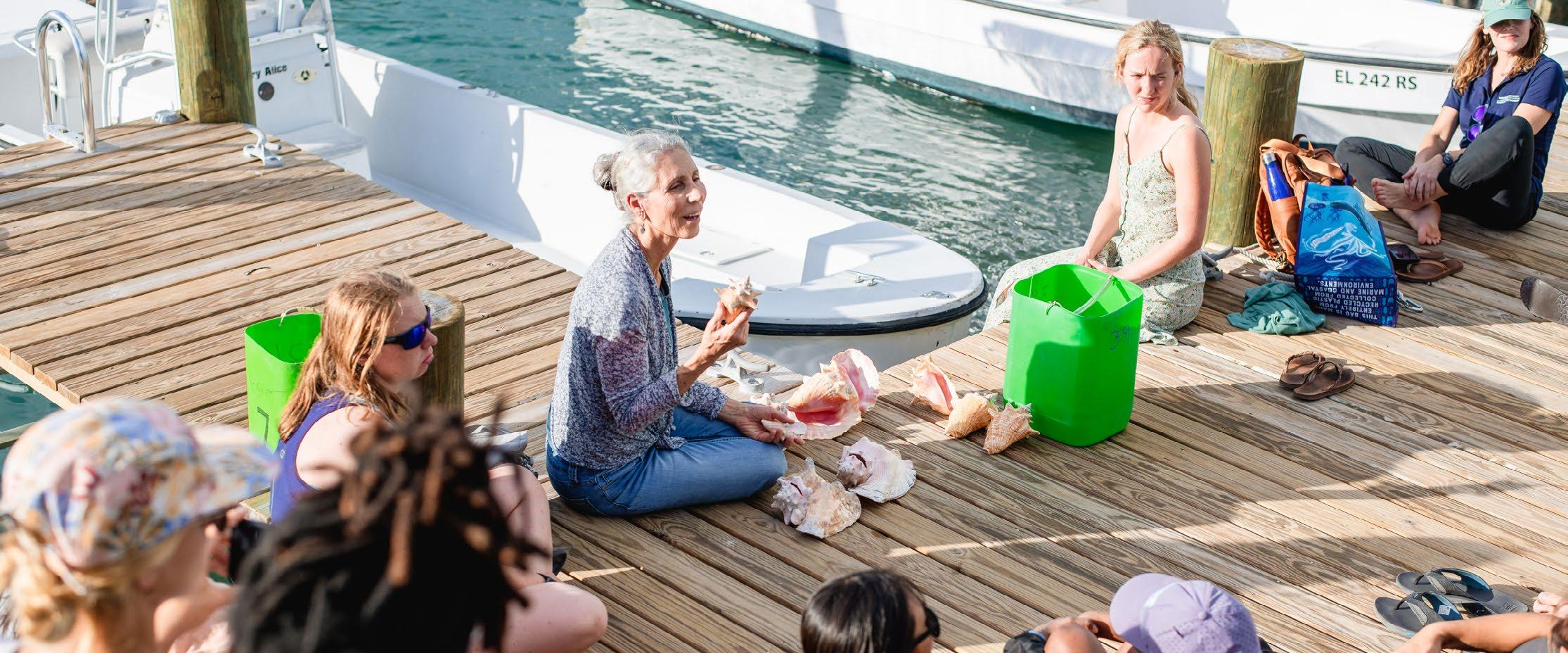
BY KENNEDY WALL & MIA AVRIL
This year, thanks to generous funding from an Anonymous Donor and support of our partners, we are excited to announce the launch of a new project, the Cape Eleuthera Queen Conch Conservancy.
This project seeks to restore queen conch populations in South Eleuthera by establishing a mobile lab hatchery in partnership between CEI and the world’s foremost expert in queen conch aquaculture, Florida Atlantic University’s Queen Conch Lab.
By engaging local communities, researchers, and experts, the project aims to rebuild conch breeding stocks, protect seagrass nurseries, support local economies, advance scientific understanding, and serve as a model for broader conservation efforts. At The Island School, we are empowering students to become active participants in queen conch research. Through hands-on experiences in applied research, experimentation, and aquaculture, we hope to inspire the next generation of marine conservationists to safeguard our oceans.
Plans are underway for establishing the queen conch aquaculture facility and developing programming surrounding our queen conch research and conservation. We hope to have the mobile lab on the ground and in operation in fall 2025, pending the acquisition of additional funding.
To prepare for this, we are working diligently with our partners and collaborating closely with community members to finalize infrastructure planning, conduct baseline environmental assessments, and train staff in sustainable aquaculture practices.
Earlier this year, Mia Avril, CEI’s aquaculture manager, visited the Blue Action Lab in Grand Bahama to participate in a training workshop on queen conch hatchery operations run by Dr. Megan Davis.
Participants learned how to handle egg masses from the ocean and techniques for acclimating them to lab conditions, as well as proper incubation methods for nurturing eggs until they hatch. They were also taught how to inoculate different kinds of algae which would be used to feed the veligers (larvae) upon hatching.
Much of this training focused on microscopy, both for monitoring eggs and veligers, as well as algal colonies.

BY NATASCHA WOSNICK
In 2024, shark scientists worldwide uncovered more evidence of the serious and potentially irreversible impact of human activity on shark populations. Globally, many species are at risk, and The Bahamas is no exception. Of the 46 shark species identified here, a concerning 63% are threatened: four species are Critically Endangered (CR), 13 are Endangered (EN), and 12 are Vulnerable (VU). These findings underscore the importance of protective measures, such as banning longlines and establishing sanctuaries, positioning The Bahamas as a beacon of hope for shark population recovery and ocean health.
At CEI, our Shark Research and Conservation Program focuses on advancing this mission through local research that addresses the needs of both The Bahamas and the global shark conservation community. This year, our team concentrated on studying the health of species of concern: the Atlantic nurse shark (VU), the lemon shark (VU), the blacktip
shark (VU), and the Caribbean reef shark (EN). We also explored the impact of tourist feeding on bull sharks (VU) to assess its sustainability and effects on shark behavior. In a unique study, we updated the occurrence data for whale sharks (EN) in Bahamian waters, research that was featured in Forbes and published in the Journal of Fish Biology
Throughout 2024, we captured and studied over 100 sharks across different life stages, sexes, and locations, including the Great Bahama Bank side, the Exuma Sound side, and the Atlantic side of Eleuthera Island. For each shark, we collected morphometric measurements and blood samples to analyze seven health markers, 69 essential and non-essential metals, and two markers of oxidative stress. The analysis of health markers was made possible through the financial support of Fundação Grupo Boticário de Proteção à Natureza via Associação MarBrasil, Brazil. We are also immensely grateful for the invaluable collaboration and generous financial

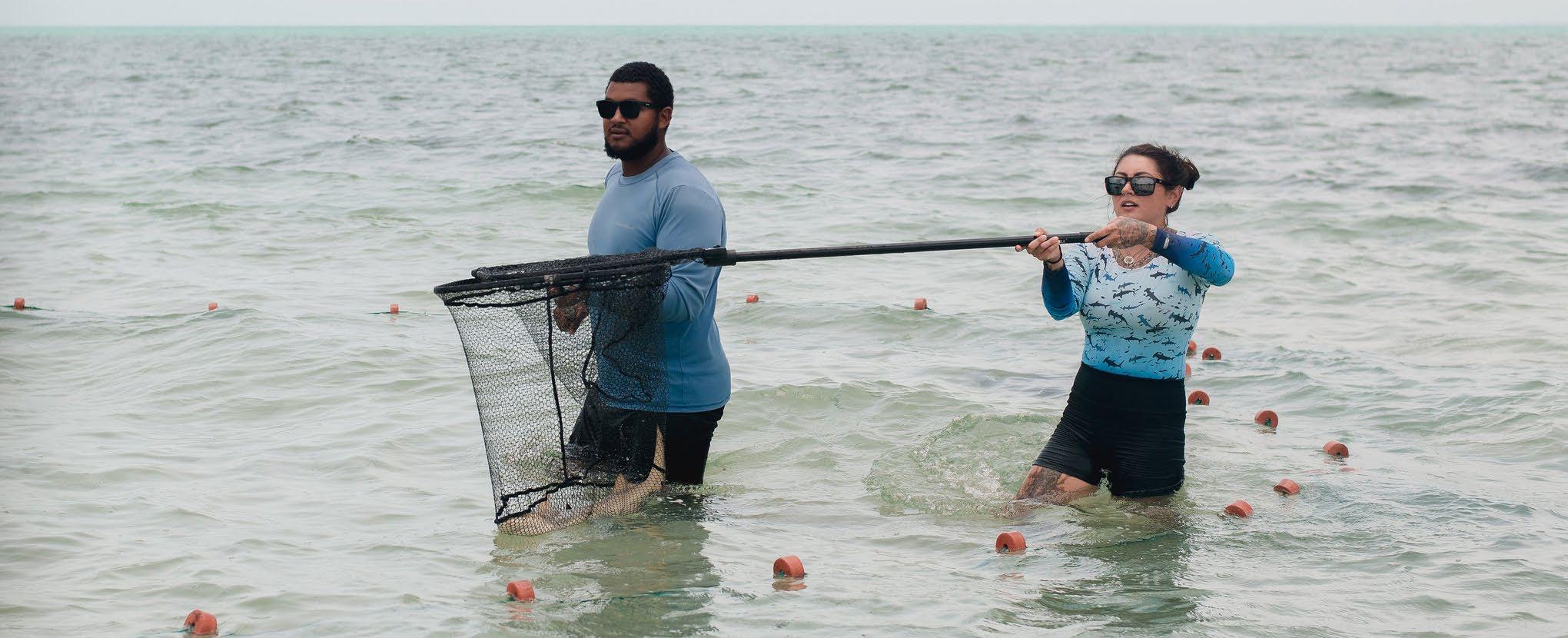
and logistical support from Dr. Rachel Ann Hauser-Davis and Fundação Oswaldo Cruz in Rio de Janeiro, Brazil, which enabled comprehensive analysis of pollutants and oxidative stress markers. Together with data from 2023, we now have health data on more than 150 sharks, providing a critical resource for understanding how pollution and other stressors impact these species.
In addition to health studies, our team explored the social behaviors of nurse sharks, specifically their interactions with sharksuckers. Published in Marine Biology with former Research Assistant Alexis Saunders and former CEI intern Meg Langlais as co-authors, this study revealed that sharksuckers often compete with nurse sharks for food, challenging previous assumptions of a mutually beneficial relationship. Our findings also showed that artificial feeding significantly alters nurse shark behavior, increasing daytime activity and time spent near the surface—both unusual behaviors for a bottom-dwelling species. Supported by the Moore Charitable Foundation, these insights were presented at the 7th International Marine Conservation Conference and will soon be published, contributing important data to inform best practices for shark tourism activities.
CEI also collaborated on the IUCN SSC SSG Position Statement regarding shark culls and control programs. This statement aims to provide guidance to governments and stakeholders on the use of shark culls as a control measure, particularly in response to an increase in shark attacks. By addressing the complexities surrounding this issue, the statement seeks to promote informed decision-making that balances public safety with the conservation of shark populations.


Our achievements in 2024 were made possible by an extraordinary group of people. Our Shark Team included five dedicated Research Assistants—Amy Brooks, George Smith, Vincent Pastor, Richard Leighton Graham, and Che Nicholls—and two skilled Research Technicians, Sarontaa Bain, and Isabelle Genier. We were also joined by four talented interns—Will Philbin-Cross, Kristin Wallace, Tamara Döerfer, and Madelyn Richardson—as well as visiting researcher Marco Turner. Additionally, we were fortunate to have hands-on field support from staff at The Island School. We are incredibly grateful for everyone’s dedication, hard work, and enthusiasm! Lastly, we would like to express our heartfelt gratitude to the Department of Environmental Planning and Protection for their continued support of our shark research projects. We are especially thankful to Dr. Suzette Lyn from the Government of The Bahamas for facilitating the export of samples by providing us with sanitary and CITES licenses for the analysis of markers and pollutants in Brazil.

Looking ahead to 2025, we’re excited to expand our work. In addition to publishing results from ongoing projects, we’ll be launching new studies. To deepen our understanding of pollution, we’ll explore how other contaminants—such as pharmaceuticals, caffeine, illicit drugs, light, and sound—may impact sharks and their environment. We’ll also examine the effects of increasing urbanization around Eleuthera on lemon shark nurseries and explore mitigation strategies. And, with the discovery of three juvenile tiger sharks near the Schooner Cays and southern Eleuthera last year, we will begin a study to determine whether these areas may serve as a pupping ground for the species, with generous support from the Lily Foundation.
Thank you for being a part of this journey. With your support, we are not only advancing shark conservation in The Bahamas but also contributing to the global effort to protect these keystone species for the health of our oceans.

BY BRETT ZITER
Discussions in early 2024 led to questions around the amount of power we use on our campus and where that energy was being used. It became apparent we were overdue for an electricity audit. This felt important given The Island School’s mission to sustainable living, as well as the costs and logistics of operating in South Eleuthera.
We were able to leverage the school’s existing data monitoring infrastructure, Campis, created in 2012 and modernized in 2016. Some of this infrastructure was in great shape. Other parts required significant rediscovery and maintenance to bring sensors back online and to understand their utility.
The Campis system can be a powerful teaching tool and an aid for data-driven science and engineering at The Island School. This report is one example of its potential. Looking ahead, we would like to see Campis used to capture data with more nuance and variety, to notify when problems arise, and to challenge us to meet our sustainability objectives.
Total
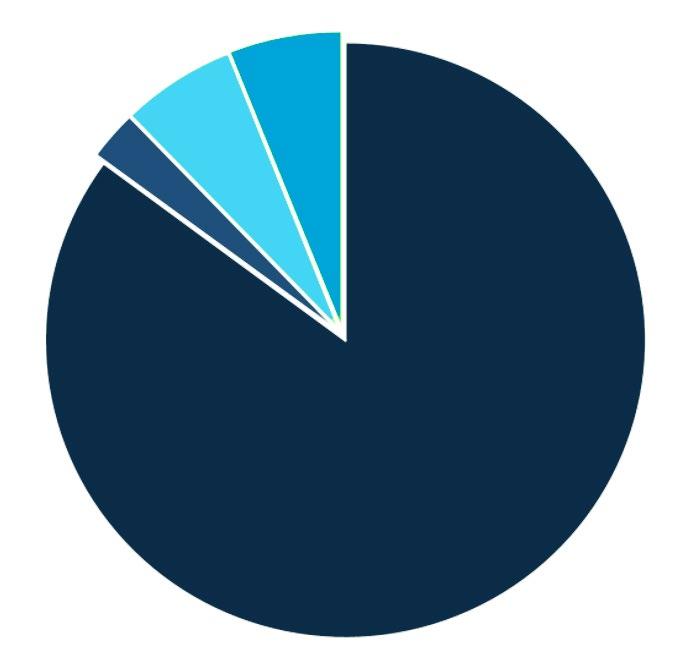


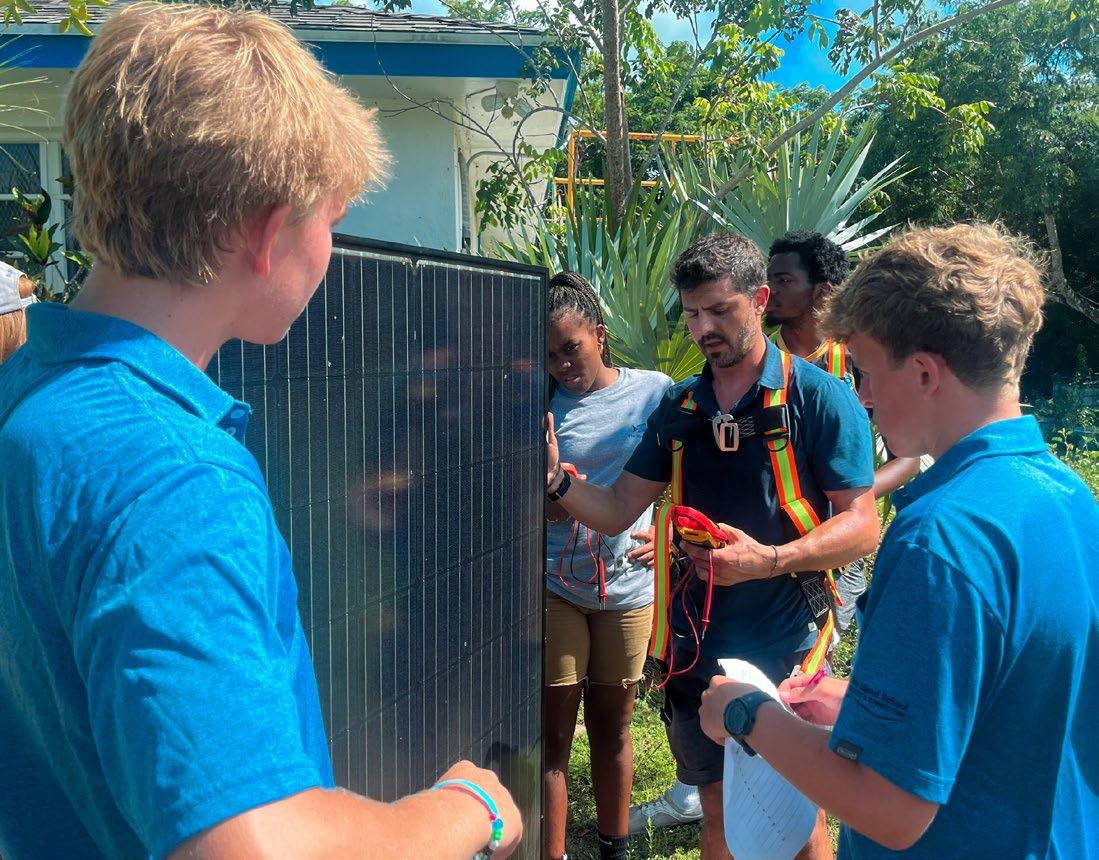
The amount of electricity used at The Island School in 2023 is equivalent to the amount consumed by 30 average households in the United States. One could argue this is a reasonable outcome, given we host a similar number of people on campus. Perhaps it’s even a good outcome, given all of the activities and research that happen here. However, in alignment with our sustainability goals, we need to do better, or at least to derive our power from cleaner sources. Electricity in The Bahamas is almost entirely derived from fossil fuels, and it’s safe to assume any power we pull from Eleuthera’s grid is generated in a diesel power plant.
In the spring of 2024, the Island School Energy Research Project embarked on a mission to re-establish and optimize as many of our renewable energy systems as possible. There is more to be done, but the results have been encouraging. Renewables production in 2024 was up by a factor 2.4 compared to 2023—that’s more than double the amount of sustainable energy!
TWO BREAKDOWNS OF WHERE WE USED ELECTRICITY IN 2024:
ELECTRICITY CONSUMPTION ON ISLAND SCHOOL CAMPUS THROUGH OCTOBER 2024

ELECTRICITY CONSUMPTION ON CEI CAMPUS THROUGH OCTOBER 2024
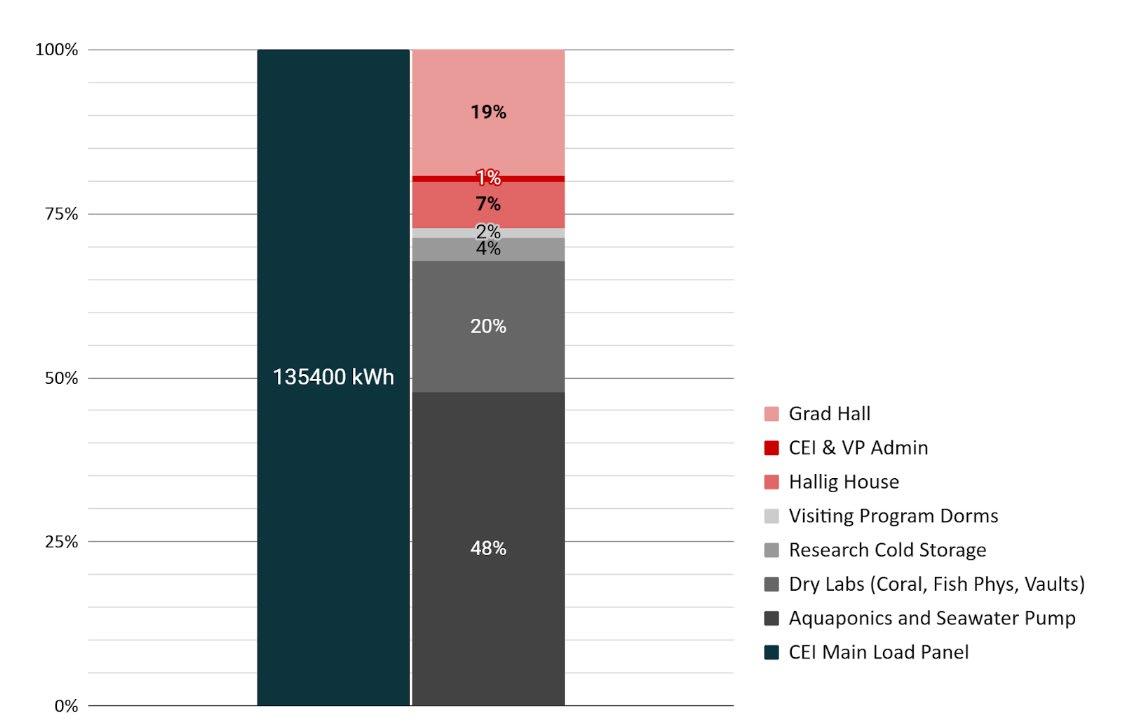
ELECTRICITY GENERATION ON BOTH CAMPUSES THROUGH OCTOBER 2024
Percentages indicate how much of our total consumption was offset by each system.

• Continue to maintain and upgrade the network of sensors that provide inputs to Campis
• Use the data in this report to achieve new efficiencies and reduce our electricity consumption
• Build out Campis water monitors to understand our water-use patterns similarly to how we understand our electricity consumption
• Develop and install a new solar PV system on campus in Spring 2025, continuing our push toward net-zero
• Define the shortcomings of our small wind turbine inverter and decide on next steps
• Re-establish the social norms that allow our campus to serve as a model of sustainability
A BREAKDOWN OF ALL CAMPUS ENERGY USE, AS WELL AS THE RENEWABLE ENERGY WE PRODUCED IN 2024

The Fall 2024 Island School Semester Energy Research Project explored the relationship between electricity consumption and solar generation at Deep Creek Middle School (DCMS). Solar panels were installed on the school in 2018 and connected to DC-powered air conditioners that have since been removed or overlooked. We aim to repurpose the existing infrastructure at DCMS to establish the first grid-interconnected solar PV system in Deep Creek.

There was a buzz in the air when we raised the wind turbine in late April 2024, with refurbished blades and repairs to the alternator. The turbine began producing electricity immediately, but has since required several adjustments to the inverter that takes power from the wind and converts it to grid-quality electricity. Think of this inverter as a large and very hard-working computer. It has had a fruitful 20-year life but has seen significant degradation. In six months of operation in 2024, our wind turbine produced a fraction of its potential and contributed very little to our electricity mix. We are now exploring if—and how—we can upgrade the inverter to improve performance.

Red line along the bottom indicates down time, often caused by high winds when we should have expected the highest power output.

A FEW NOTES:
2024 stats in the pie chart use real data through the end of 2024. The bar charts are as of October. Solar data includes a small amount exported into the grid, left in the dataset to highlight our true offset. The wind turbine was offline all of 2023 and about half of 2024. Dollars saved are calculated based on costs avoided and credits provided by the BPL net-billing policy. Diesel avoided assumes 3.5 kWh/L, a reasonable assumption for large diesel generators. Emissions avoided use 2.7 kg CO2eq per liter of diesel burned. Send questions and comments to brettziter@islandschool.org
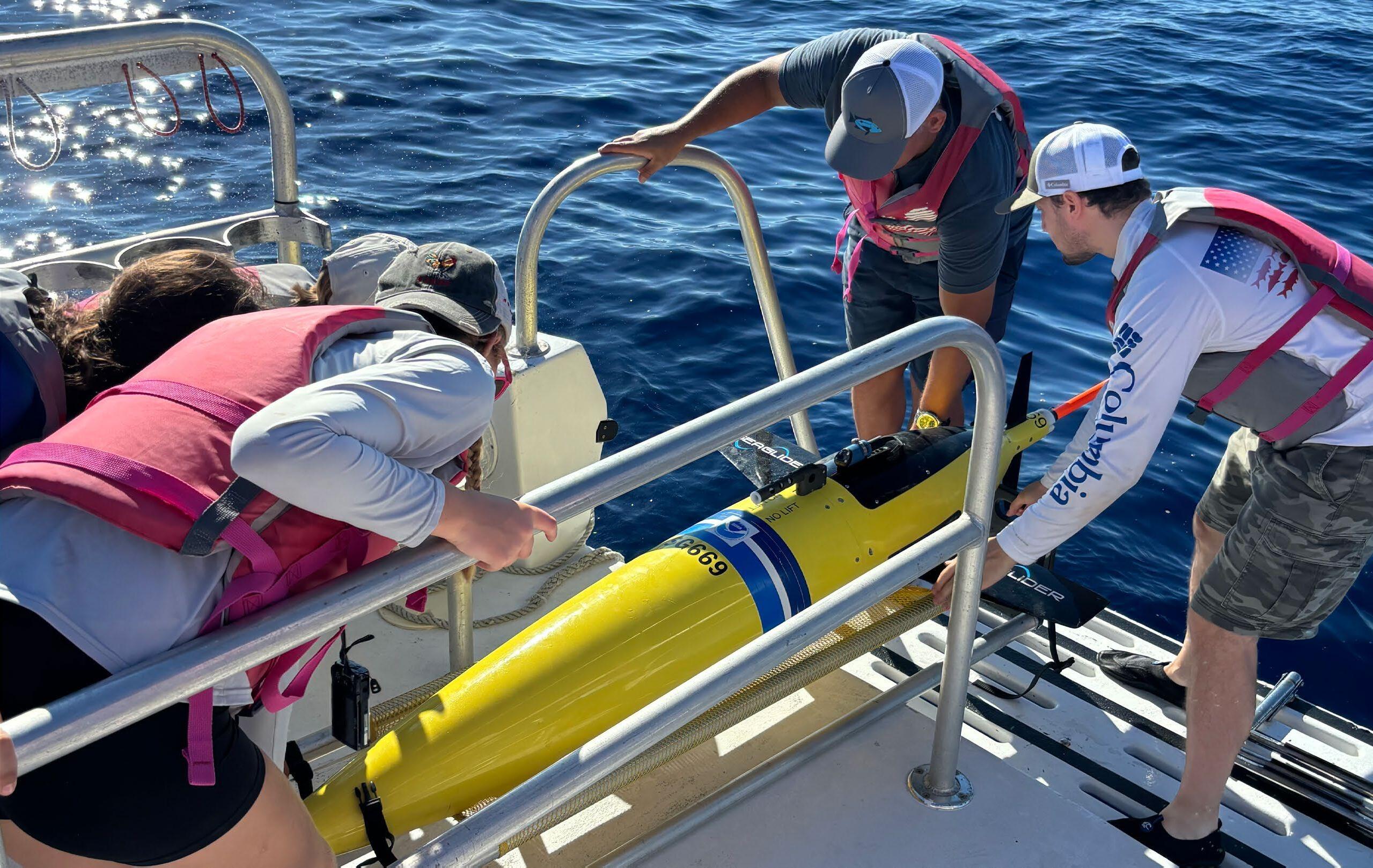
BY ANDREW TREAT
In the fall of 2024, The Island School offered its first oceanography-based semester student research project. Led by teacher Andrew Treat, this project explored the abiotic factors (non-living elements) of the ocean. Specifically, this project examined how ocean temperatures, salinities, and densities vary off of the coast of Cape Eleuthera.
Over the course of the semester, students participated in hands-on oceanographic research that involved collecting temperature and salinity data up to 30 meters below the ocean’s surface. Collecting this data by hand, a team of six students dedicated time and energy into researching the types of water masses that are present off the coast of Cape Eleuthera,
looking specifically for warm, salty plumes of sea water descending from the Bahamas Banks into the Exuma Sound.
The implications of these plumes are that these hyper-saline, high temperature blobs of water have been shown to increase coral stress and possibly alter surface water phytoplankton regimes. Without an oceanographic buoy to consistently collect data, it’s been up to the oceanographic research team to lower and retrieve a weighted probe multiple times during a data collection day. Needless to say, our team earned their sea legs and built some serious arm strength during this semester.
Our students also had an incredible opportunity to join researchers from the University of Miami and the National Oceanic and Atmospheric Administration (NOAA) and CEI during glider retrieval and deployment missions. CEI has a long-standing relationship with NOAA, which allowed our students access to these cutting-edge pieces of oceanographic equipment, as well as the data they collect. The students engaged with the sea glider by helping with the deployment process, speaking with NOAA technicians, and even getting to work on the glider itself. We are grateful to NOAA for their continued alliance in monitoring ocean conditions off the coast of Eleuthera and for their willingness to include Island School students in their field work.

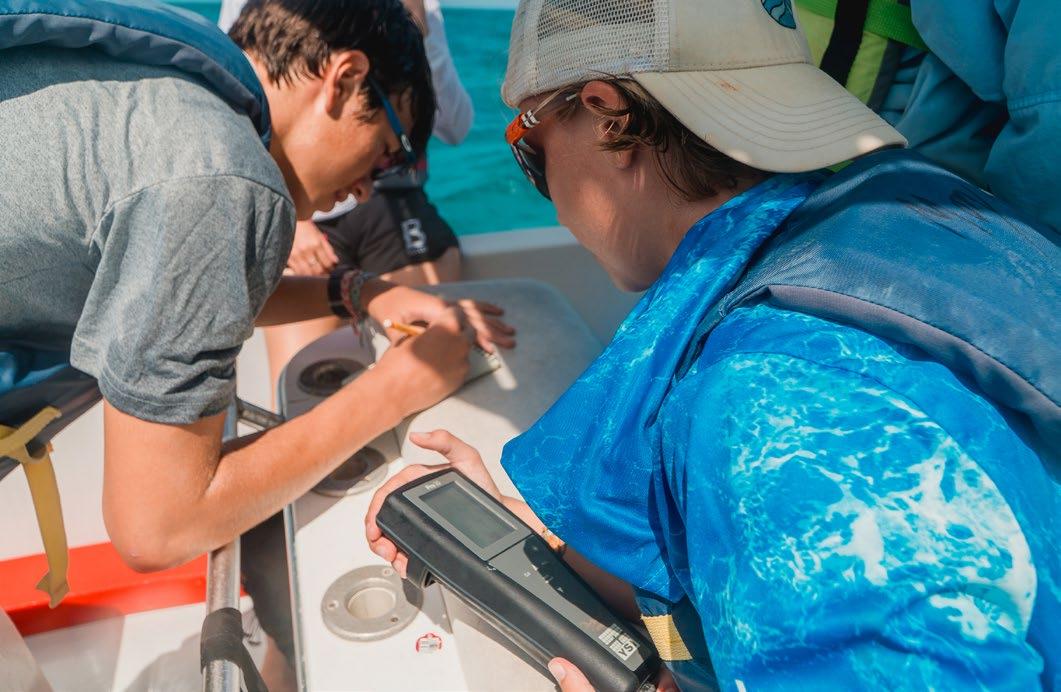


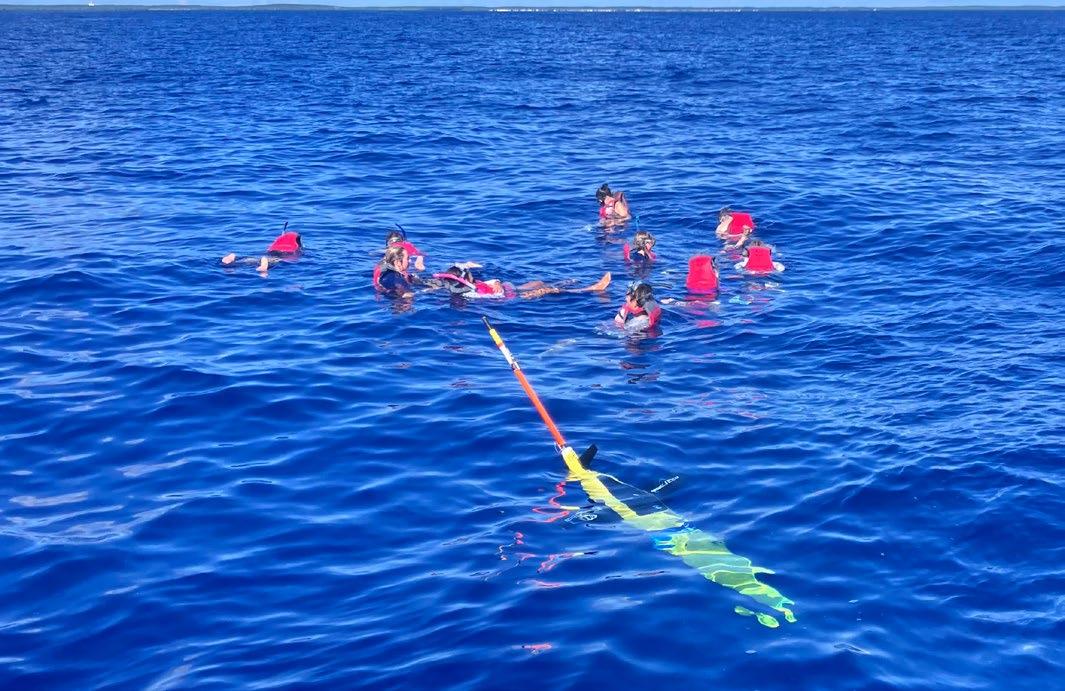
LETTUCE PRODUCTION

TILAPIA PRODUCTION

*Note: October harvest was whole fish (scaled and gutted). All other harvests were filets.



BY NATALIA HURTADO & SILIA WOODSIDE


Coral reefs are increasingly threatened by numerous stressors that are depleting coral populations faster than they can naturally recover. To address this decline at local scales, active coral restoration efforts have been implemented across the Caribbean. Since 2018, The Nature Conservancy (TNC), Cape Eleuthera Institute (CEI), and the Perry Institute for Marine Science (PIMS) have combined their scientific expertise and resources to advance coral restoration through the Bahamas Coral Innovation Hub (BCIH) project, based at CEI.
The primary aim of coral reef restoration is to maintain or bring back ecological functions and ecosystem services, objectives that can potentially be achieved on local scales. Work at the BCIH focuses on three key objectives to restore Bahamian reefs:
1. Enhance and diversify restoration efforts through a multi-technique approach.
2. Establish and maintain long-term monitoring of restoration projects in South Eleuthera.
3. Engage students locally and internationally in coral reef restoration and create educational and research opportunities for Bahamians and emerging scientists.
OBJECTIVE 1 : Enhance and diversify restoration efforts through a multitechnique approach
OCEAN-BASED NURSERIES
To regrow corals for restoring reefs, the BCIH fragments (i.e., cuts into small pieces) wild colonies and grows them on mid-water structures that speed up their growth relative to when they are growing on the seafloor. In collaboration with the PIMS Reef Rescue Network, BCIH staff built and continue to maintain ocean-based nurseries comprised of two different types of structures for growing out corals, each designed to accommodate the morphology of the coral species being grown. The Tunnel Rock nursery includes 17 coral tree structures
and one table structure while the Harbor Rocks nursery has three coral trees. Across both nurseries, there are 692 coral fragments from 16 source colonies and three coral species growing, including critically endangered Staghorn and Elkhorn coral.
Unfortunately, after a mass bleaching event in 2023, the coral nurseries lost 80 percent of their fragments due to mortality. Since genetic diversity is key to ensure resilience, our team visited different sites in Eleuthera to find resilient genotypes and collected new fragments from Half Sound and The Schooner Cays. Our team identified sturdy and heat resilient genotypes that survived. These genotypes were collected, fragmented, and added to the nurseries, where they are currently thriving and continuing to be propagated. Corals that survived the bleaching event at the BCIH nursery were used to expand coral restoration efforts in Eleuthera. These new nurseries include line and coral trees at Lighthouse Point (Disney’s Lookout Cay), as well as domes and coral trees at Gregory Town (The Cove) were established through the Reef Rescue Network and populated by our team.
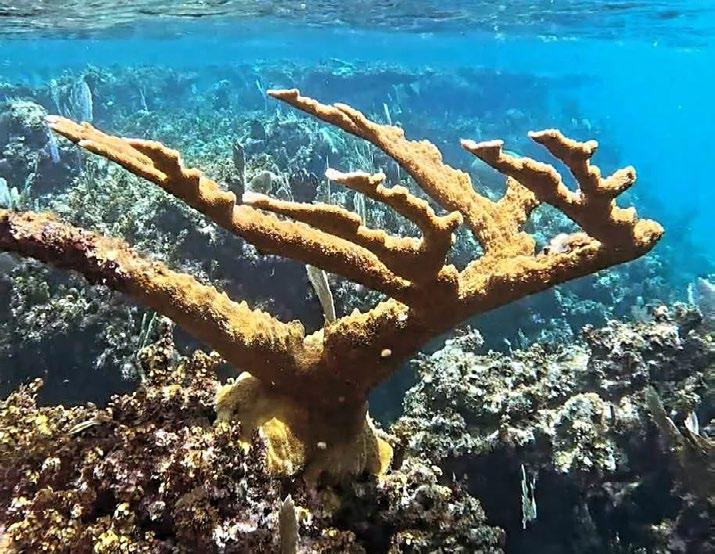

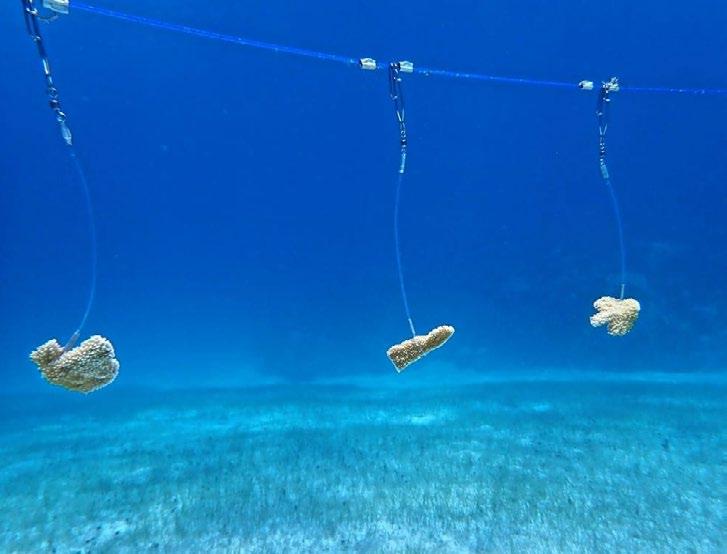
4
Nursery locations in Eleuthera (2 new sites populated with fragments from BCIH nursery)
22
PADI Reef Rescue divers
3 International Conferences
435
Out-planted corals monitored in 4 dive sites
2
Articles for the local newspaper - The Eleutheran
692
Coral fragments maintained in 20 coral tree nurseries
32
PADI AWARE Coral Reef Conservation divers
16
Source colonies (6 new genotypes)
21
Sea urchin collectors
48
Dive trainings (Open, Advanced, Rescue, EFR, Oxygen Provider, Fish ID)
The BCIH land-based facility has been steadily growing since its inception in 2019. The facility is a contingency plan to maintain genetic diversity with replicates from the ocean-based nursery, perform experiments with corals to improve restoration strategies in the wild, and propagate larvae of several species for study and restoration. An outdoor and indoor system were established and The Hub’s wet lab water has been optimized for coral growth and experimentation with specialized filtration systems and lights to stabilize environmental conditions and protect against pathogens.

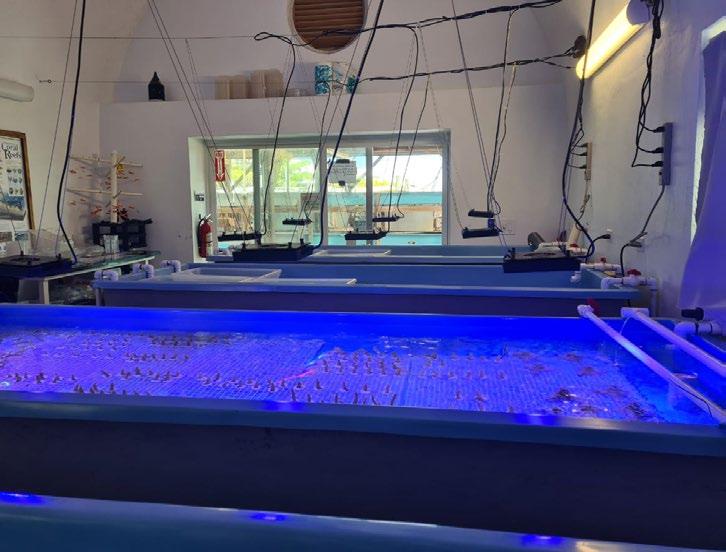

Corals reproduce sexually by releasing their gametes into the seawater for fertilization in a process called spawning. During coral spawning events, gametes can be collected by divers and reared in lab facilities where fertilization and survival is higher than would occur naturally in the ocean. The resulting coral offspring can then be returned to the reef where they will continue to grow and increase coral cover. Since 2020, the BCIH has been compiling spawning observations of key reef-building coral species for The Bahamas and calculating their predicted spawning times and dates. These predictions have accurately identified spawning peaks for the region. A booklet was released with key information to help local scientists, grassroots nonprofits, dive organizations, and volunteers to work together with larval propagation techniques to enhance sexual coral reproduction of corals.
After a mass bleaching event in 2023, coral spawning was expected to be reduced, however, our team successfully reared sexually produced corals from the mountainous star coral (Orbicella faveolata) and the golfball coral (Favia fragum). A Coral Rearing in situ Basin (CRIB) designed by the NGO SECORE was set up at The Island School. Additional larvae were maintained at the land-based facility for heat tolerance experiments in order to further identify resilience among the next generation of corals.


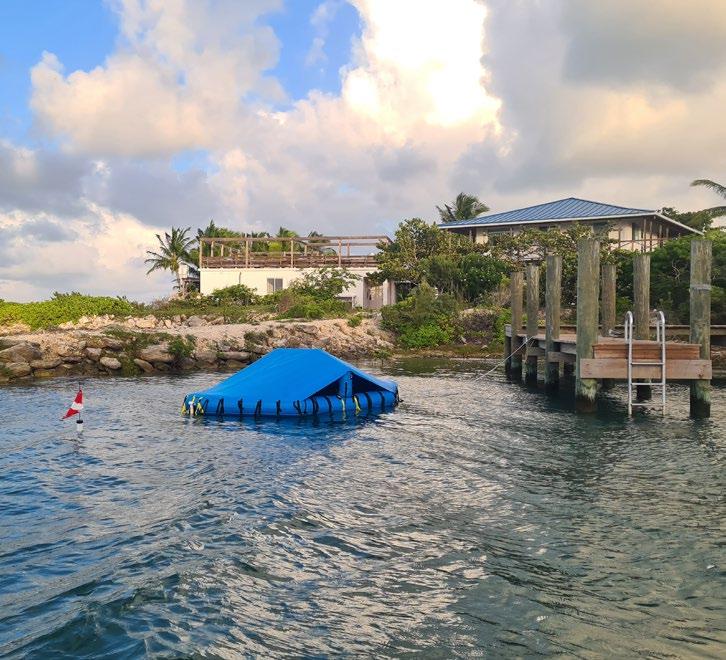
The long spined sea urchin (Diadema antillarum) play a key role on healthy reefs. These motile invertebrates graze macroalgae, allowing for benthic organisms such as corals to colonize the newly-opened space. Unfortunately, this urchin species suffered a massive die-off in the early 1980s and again in 2022. Without intervention, this keystone species and its critical function could be lost. Supported by the 2Day 4Tomorrow Foundation and after joining the Diadema network, a series of urchin collectors were installed at predetermined sites near BCIH where high abundance of adult D.antillarum was identified to collect and rear post-larval settlers. The collectors were checked monthly, though unfortunately settlers were not observed. Instead, three juveniles were observed on the coral tree nurseries and were transferred to the lab facilities, where they have been reared into adults. Our team will start trials in the land-based facility, using adults and inducing spawning to collect gametes to be fertilized and produce larvae and adults, following the techniques and protocols established by Wageningen University and Research.
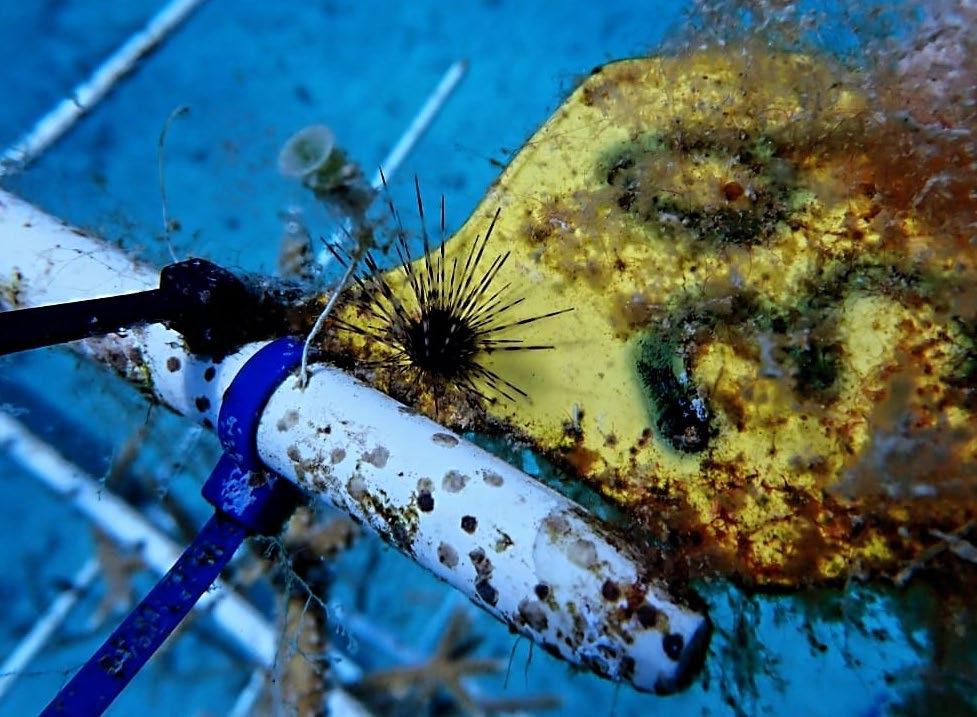
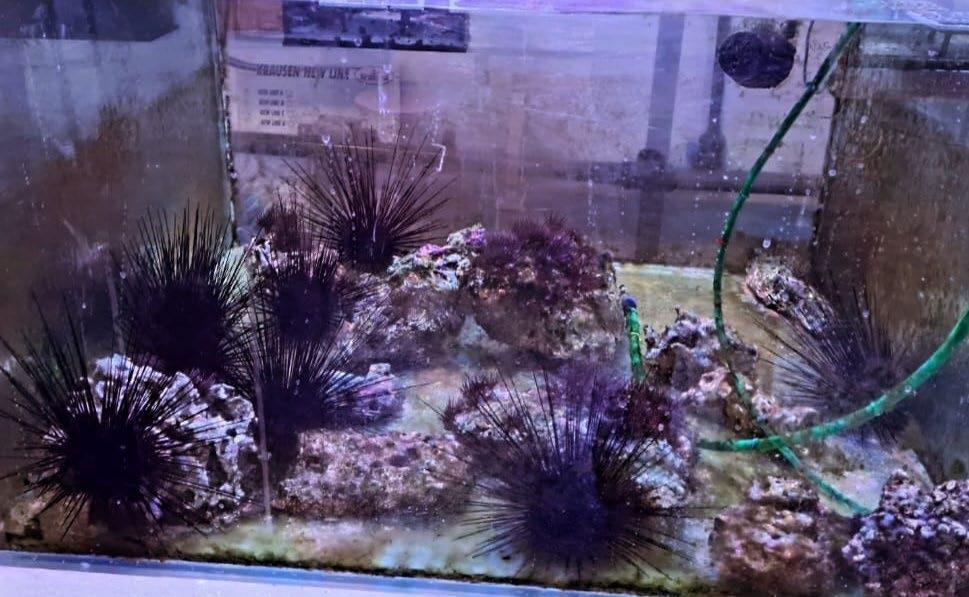
Microfragmentation is a relatively new coral restoration technique in which corals are cut into very small fragments (roughly 1-2 cm2), which initiates a rapid growth response. Microfragmentation can increase coral growth rates up to 50% in slow growing but essential species such as star corals. As part of the Island School Student research project in the fall semester, students gained hands-on experience using this technique. Additionally, to implement the use of sustainable materials into our coral restoration efforts, the students compared growth rates of micro-fragmented coral on different types of substrate: a commonly used cement mixture vs. pieces of conch shell, a commonly discarded material in The Bahamas. Students helped install a table nursery to place the micro-fragments on and learned about the importance of coral nurseries and their maintenance in the success of coral restoration efforts. Preliminary results suggest that conch shells promote faster growth than cement substrates. This finding indicates that conch shells could serve as a cost-effective and more sustainable substrate, as they are typically discarded as waste and readily available at no cost.



OBJECTIVE 2 : Establish and maintain long-term monitoring of restoration projects in South Eleuthera
Consistent monitoring is essential for assessing the success of restoration efforts and understanding the impact of environmental changes and diseases on restoration sites. Our team has been monitoring nurseries, restored natural sites, and non-restored natural sites through photogrammetry, also involving semester program students attending The Island School. As part of the spring research project, students learned to ID corals and fish and helped conduct field surveys to determine the extent of coral loss after the prolonged heatwave and bleaching in 2023. They identified species-specific patterns, such as the recovery of star corals and the high mortality of brain and finger corals. Staghorn corals out planted at four locations across South Eleuthera were also impacted, with outplants at John Millar´s Blue Hole being the only survivors. Sexually produced corals survived the heatwave giving us hope and proving our coral restoration efforts successful, as wild colonies died in the same out planted areas.



After bleaching events, corals become more vulnerable to diseases. The Bahamas has faced severe coral loss due to Stony Coral Tissue Loss Disease (SCTLD) even prior to recent heatwaves. SCTLD poses one of the greatest threats to coral reefs, as it is both highly lethal and spreads rapidly due to easy transmission through water circulation. This disease is capable of killing a coral within weeks. Since SCTLD began spreading in The Bahamas, our BCIH team has been actively monitoring its presence in Eleuthera and treating infected coral colonies with antibiotics to help mitigate its impact. Treatments have been effective in some coral species but unfortunately the boulder brain corals are easily reinfected, making it difficult to stop the spread. Star corals however, have responded positively to treatments and have shown complete recovery.




OBJECTIVE 3 : Engage students locally and internationally in coral reef restoration and create educational and research opportunities for Bahamians and emerging scientists
Our lead coral scientist, Natalia Hurtado, started the project: “Towards resilient reef restoration, using larval propagation” as part of her PhD in collaboration with Wageningen University & Research in The Netherlands. The main goal of this project is to identify and breed heat resistant corals that can survive warming ocean conditions. Over time, this approach could improve reef functions while building resilience to major disturbances in coral populations and communities, while understanding trade-offs in early life stages (i.e., does gaining heat tolerance mean losing other functions). Two students successfully completed their Masters degrees at Wageningen University, doing research at BCIH on heat tolerance in two coral species (Favia fragum and Orbicella faveoloata) and identifying resiliency. Our team also hosted and collaborated with a visiting researcher from Wageningen University. The PhD candidate examines swimming behavior and feeding patterns of larvae exposed to heat and the coral recruits obtained after heat experiments will be the focus of future studies by the Hub.


CONFERENCES AND COLLABORATIONS
Collaborations and networking are key to advancing and maximizing the impact of coral restoration techniques. Attending conferences allows for invaluable opportunities to learn about innovative methodologies and to highlight the research and initiatives being done by the BCIH. This year, our team presented their work at the Science day “Animals in a changing world” in Wageningen, The Netherlands, also at the Latin America and Caribbean Aquaculture conference in Colombia. Our BCIH team has attended Reef Futures in Mexico, one of the most important coral restoration conferences in the world. Our team has been working with The Department of Environmental Planning & Protection (DEPP) and the Ministry of Health, to share awareness about climate change and its impacts on our environment, including touring DEPP officers in our land and ocean based facilities.



BY
KURT
The Tropical Marine Ecophyiology (TMEP)-Lab at CEI had a busy but productive year in 2024.
We continued to: teach research with semester students, add research capacity to the TMEP-Lab facilities, and conduct research on both a variety of species and on a diversity of scientific questions. We also worked towards improving our campus facilities and acquiring equipment that would allow for a number of biochemical measurements to be performed. This equipment includes a wall-mounted distillation unit to produce distilled water, a multifaction plate reader, a refrigerated centrifuge with multiple rotors, an analytical balance, and a pH meter, among other tools. This equipment allows us to expand our research and improve our data collection.
In 2024, Emma Porter, a Ph.D. student at Memorial University, taught fish physiology research classes to both Spring and Fall Semester Students at The Island School. The Spring 2024 research project investigated how growth/production parameters and fish morphometrics of Nile tilapia ( Oreochromis nilotica ) were affected by various diets in collaboration with Mia Avril, the Aquaculture Manager at CEI.
These ongoing diet trials compare a traditional commercial pellet feed to feed formulated from locallysourced ingredients such as fish discards, soldier fly larvae, and brewery malt. The results from these trials were very promising, as they showed that tilapia fed a locally-sourced diet had similar growth and feed conversion ratios to fish fed the commercial diet.
The Fall 2024 fish physiology student research project examined how acclimating the same tilapia, which were bred and reared in the aquaponics system at CEI, to 25ºC compared to 32ºC affects their metabolic capacity and thermal tolerance.
Tilapia that acclimated to the warmer temperature had a slightly higher upper thermal tolerance (i.e., 41.5 vs. 40.6ºC), and resting and maximum temperatureinduced metabolic rates. However, their metabolic scope (maximum – resting metabolism) was not different. This suggests that warm acclimation may extend the upper thermal limit of this species, which may be beneficial during the summer months or during extended heatwaves, which are increasing in frequency and severity due to accelerated climate change.
Last year, Porter led two projects aimed at understanding fundamental aspects of how the fish heart functions.
In the spring, she examined the relationship between central venous pressure (CVP) and cardiac function in Nile tilapia. In the first experiment, she developed and

validated a surgical technique to measure CVP in this species and investigated how an acute temperature decrease from 30ºC (86ºF) to 24ºC (74ºF) impacted the relationship between heart rate and cardiac output.
These data suggest that the stroke volume (VS) of tilapia is less sensitive to changes in CVP when temperature is acutely lowered, which means that the heart continues to function in a normal fashion.
In the second series of experiments, she examined the relationship between CVP and cardiac function when tilapia held at 25ºC (77ºF) are exposed to a number of conditions:
1) temperatures from ~ 10 to 40ºC (~ 50 to 105ºF)
2) a decrease in water oxygen levels to 30ºC (86ºF) and then an increase to 40ºC (105ºF)
3) an increase in temperature to 40ºC (105ºF) after the fish is given a drug to limit heart rate increases (i.e., making the fish more reliant on how much blood is pumped by the heart per beat).
These experiments have provided a number of unique findings and have greatly increased our understanding of how the fish heart responds to realworld environmental challenges.
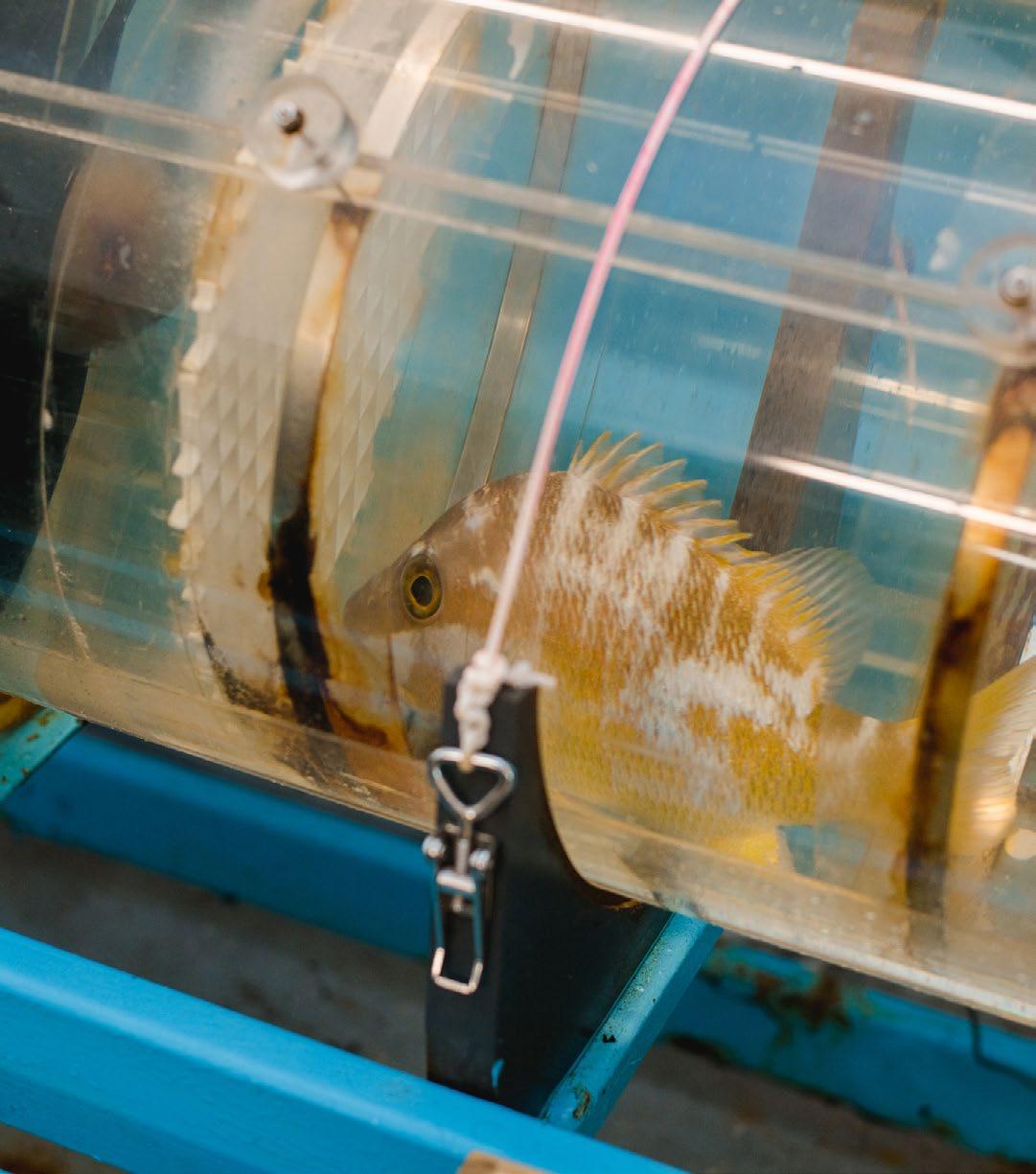
Emma’s second project began in September and examined how short-term increases in temperature influence the electrical activity of the fish heart and how changes in the heart’s electrocardiogram (ECG) change as fish approach their upper thermal tolerance. These experiments were conducted on small juvenile tilapia and scaled sardines ( Harengula jaguana ).
In the spring of 2024, Fiona van den Bogaert, a M.Sc. student at Memorial University, spent two months at CEI conducting experiments that will comprise part of her thesis. In 2023, we determined the maximum swimming speed, upper thermal tolerance (CTMax), and upper thermal tolerance while swimming (CTSMax) of subadult (~ 250 – 300 g) schoolmaster snapper ( Lutjanus apodus ). This research revealed, surprisingly, that the thermal tolerance of fish swimming near maximal levels was only slightly lower (~ 1.5ºC, 3ºF) than measured in fish at rest. This was due to the ability of swimming fish to achieve a much greater maximum oxygen consumption than fish at rest during the trial. However, we did not know the physiological factors or mechanisms that allowed for this much higher metabolic rate.
The goal of Fiona’s project was to determine how these fish achieve their higher metabolic rate. To do this, she measured oxygen consumption and cardiac function, as well as tissue oxygen extraction, in fish
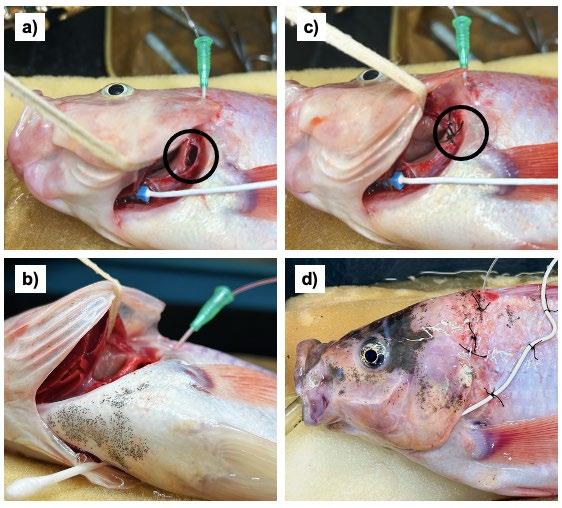
exposed to these three tests. This research revealed that the enhanced maximum metabolic rate in swimming snapper when warmed was due to them achieving a much higher heart rate and being able to extract more oxygen per milliliter of blood that passes through the tissues. This research suggests that tropical fish swimming near maximum speeds may not be as susceptible to high temperatures as previously thought, and that changes in heart rate control and tissue oxygen extraction are key to the thermal tolerance of this species under varied conditions.
Dr. Kurt Gamperl also visited CEI throughout 2024 and performed preliminary experiments and designed protocols for assessing the swimming ability and capacity—as well as the thermal tolerance—of the scaled sardine.
This is a ‘forage fish’ in the Caribbean that is key to food webs and ecosystem health, however there is very little understanding of these organisms. Dr. Gamperl’s preliminary experiments revealed that these fish can swim at very high speeds (~ 6 body lengths sec; 0.7 m s-1) given their small size (< 10 cm / 25 g; 4 inches in length) for prolonged periods, and that this species has by far the greatest metabolic rate per kilogram of any fish measured to date (about twice that of tuna).
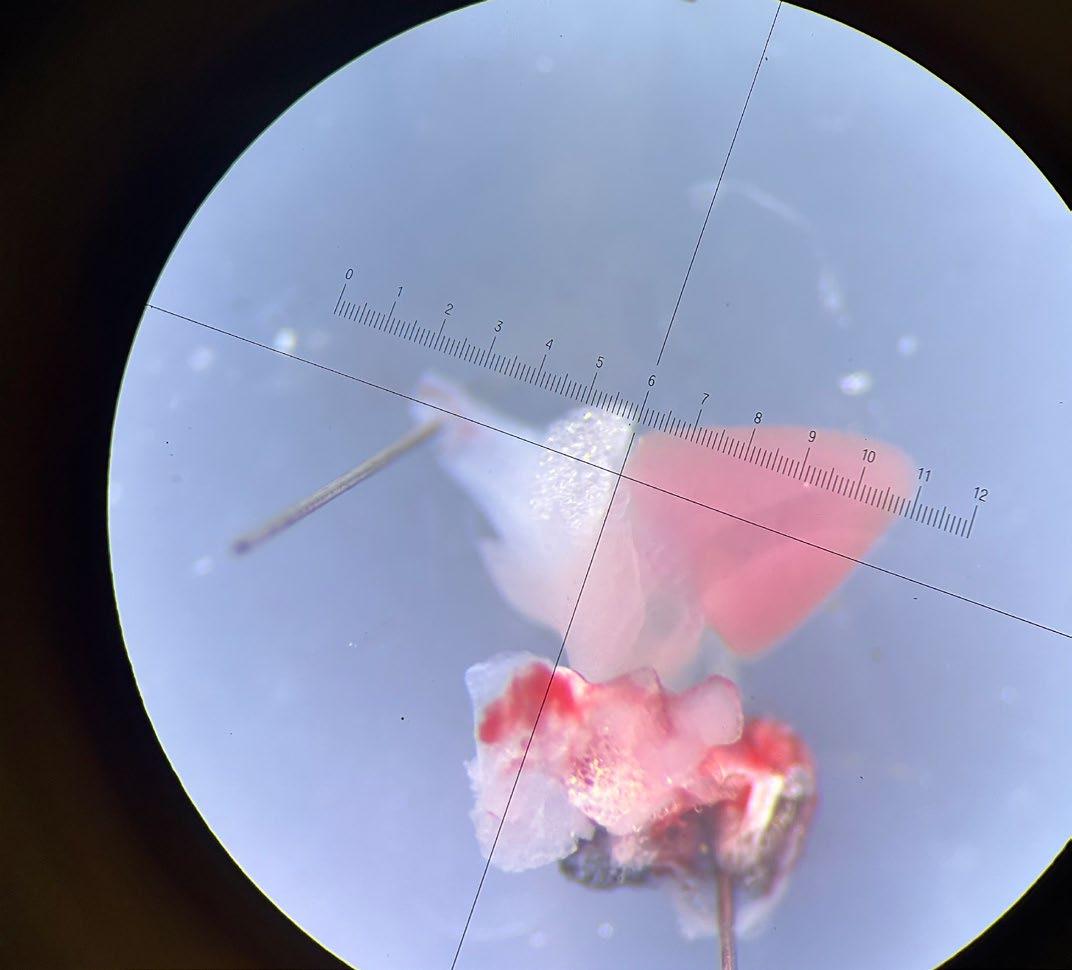
During his visits, Dr. Gamperl worked with Emma Porter and TMEP-LAB Research Assistant Amy Brooks to measure their upper temperature tolerance. These experiments wrapped up at the end of the year and will be built upon in 2025.
In June, Dr. Gamperl travelled to the Bahamas Agriculture and Marine Science Institute (BAMSI) on Andros to meet with Dr. Scott Seamone and other BAMSI staff with regards to the development of their facility and research capacity, and to discuss partnership opportunities between CEI, BAMSI and Memorial University.
Following Dr. Gamperl’s trip, Dr. Seamone paid a visit to CEI to explore the facilities, meet with Dr. Nick Higgs, and to talk about collaborative research projects. These meetings were very successful and should allow BAMSI and CEI to move forward with projects in marine science under the MOU that was recently signed. Currently, Drs. Gamperl and Seamone are writing a funding proposal to bring several BAMSI marine science students to The Island School in April 2025 to broaden their education in this area and to teach them valuable skills and techniques. Dr. Seamone will also be staying for a
month to conduct collaborative research on sardines and lobster ( Panulirus argus ) physiology.
To promote the TEMP-Lab and CEI as a ‘research destination’ for scientists interested in marine organism physiology, Dr. Gamperl presented a talk at the American Fisheries Society meeting in Hawai’i in August. The talk was titled: Tropical Fish Physiology in the Era of Climate Change: The TMEP- Lab. The talk / meeting was very successful, and Dr. Gamperl is currently in preliminary discussions with respect to two other scientists visiting the IS/CEI to conduct research.
Dr. Gamperl, Emma Porter and Amy Brooks have also been working with Drs. Nick Higgs and Eric Schneider to improve the quality of water (chemical composition and clarity) that supplies tanks in the CEI research facility and to improve fish health / welfare, and there have been preliminary discussions on what additional facilities CEI could use [e.g., a laboratory for the rearing of eggs, larvae and juveniles in support of fish and invertebrate (conch, lobster) research and aquaculture].
P. Malorey, E.S. Porter, A. K. Gamperl, M. Briffa and A.D.M. Wilson (2024). Swimming performance, but not metabolism, is related to the boldness-activity syndrome in schoolmaster snapper (Lutjanus apodus). J. Fish Biol. https://doi.org/10.1111/jfb.15900
J.H.H. Nati, P. Malorey and A.K. Gamperl (2024). Near maximally swimming schoolmaster snapper (Lutjanus apodus ) have a greater metabolic capacity, and only a slightly lower thermal tolerance, than when tested at rest. J. Exp. Biol. https://doi.org/10.1242/jeb.249273
R.M. Sandrelli, E.S. Porter and A.K. Gamperl (2024). Hyperoxia does not improve the upper thermal tolerance of a tropical marine fish (Lutjanus apodus). J. Exp. Biol. https://doi.org/10.1242/jeb.247703
E.S. Porter and A.K. Gamperl (In Press). Effects of acute cooling and bradycardia on central venous pressure and cardiac function in Nile tilapia (Oreochromis niloticus). J. Comp. Physiol. B (submitted)
BY DR. NICK HIGGS & DR. ERIC SCHNEIDER
We made an exciting new discovery in the Exuma Sound. An international group of researchers, including scientists at CEI, recently published the scientific description of a new species of deep-sea isopod called Booralana nickorum.
Our team first trapped a specimen of the isopod in 2014 and returned years later to further investigate. In 2019, researchers from CEI joined a scientific mission in the Exuma Sound with researchers from Stony Brook University and OceanX to document deep-sea biodiversity. Several more specimens were collected using light-traps, and the formal identification and description process began.
Isopods live in marine habitats around the world and many are only a few centimeters long. Prior to this exciting discovery, scientists believed that there was only a single species of Booralana that existed in the Northwest Atlantic Ocean, Booralana tricarinata. However, with the discovery of this newly identified species, there are officially two in the genus from The Bahamas.
We found this isopod at around 550 meters (1,800 ft) deep, and it is only about the length of your pinky finger.

Although this species is small, it plays an important role in its environment. Isopods speed up the decomposition of plant and animal matter, which benefits the entire ecosystem. These scavengers make the nutrients in this falling organic debris available in the deep-sea food web to ensure the productivity of these ecosystems.

BY MARCO TURNER
In many fisheries around the world, tagging and markrecapture experiments are a useful tool to research population dynamics. In 2024, CEI partnered with Acadia University in Canada to begin a spiny lobster tagging project. The goal of this project is to provide valuable information about spiny lobster movement around Eleuthera, alongside model methods for monitoring the fishery in The Bahamas.
Spiny lobster are documented to have extensive migratory ranges, with some species migrating hundreds of kilometers. This project serves as one of the first spiny lobster tagging projects in The Bahamas and aims to provide insight into the use of lobster condos throughout the fishery. The


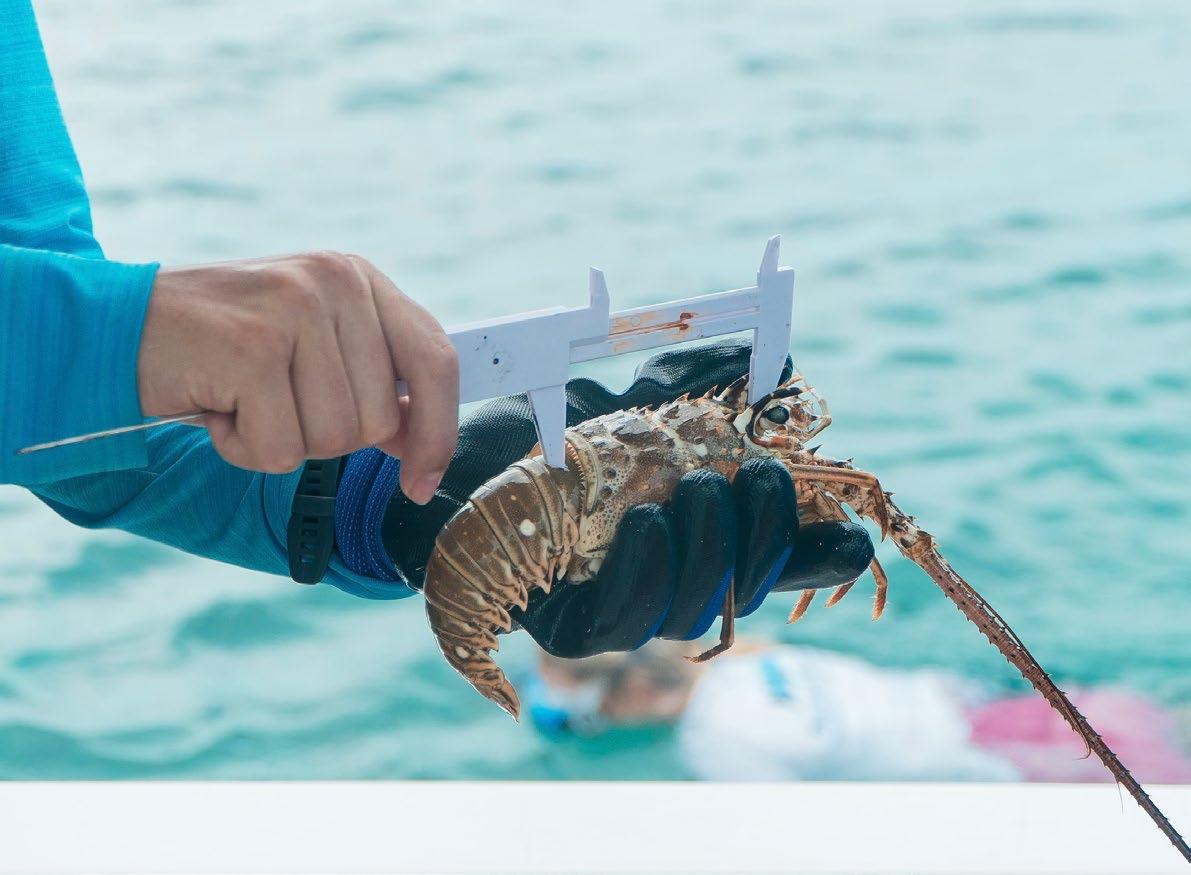
spiny lobster fishery is the most valuable fishery in The Bahamas, and so ensuring its continued success is vital to the economy here, especially in Eleuthera.
So how do you tag a lobster? Last year we tagged over 500 spiny lobsters with t-bar tags. These small tags are a unique identifier so that we can identify the specific lobster upon recapture. The tag is placed in between the carapace and the tail, allowing for retention for multiple molts. For most tag-recapture studies, scientists hope for approximately a 5-10% recapture rate, which we have already achieved. This project also partnered with local harvesters, relying on them to help recapture lobsters.
This project began with Marco Turner, a Bahamian scientist who completed his MSc at Acadia University. Marco was awarded a grant from the Robin Rigby Trust, which allowed him to cover some of the project costs and join the CEI community. Our very own director of research Dr. Nick Higgs oversaw this project, with a vested interest in its success thanks to his spiny lobster research ties.
Preliminary results have shown that many of the lobster in the waters surrounding Eleuthera have high residency within a specific condo, but some of the lobster have made it all the way up to Current Island, close to 60km away over the course of a few months. We have also been able to calculate growth rates, and discuss regeneration/ healing rates over the course of our sampling period.
BY MIA AVRIL & MADELYN RICHARDSON
Ongoing work at CEI aims to assess the feasibility of specially designed grow-out cages for Caribbean spiny lobster (Panulirus argus) aquaculture in The Bahamas. The cage trial involves juvenile Caribbean spiny lobster and is a continuation of a previous cage trial with the same species that we conducted at the end of 2023. The grow-out cages were deployed for several months prior to the start of the trial to allow for algal growth and settlement of small invertebrates to occur, as this biofouling is the diet of the lobsters. In these cages, the juvenile spiny lobsters will not only have access to their natural diets, but also protection from predators.
For this trial, thirteen juvenile spiny lobsters that had been growing in the CEI wet lab were weighed, had their carapace length measured, and were placed in individual containers for transport. They were then assigned and placed in a grow-out cage located outside Kemps Creek. Periodically, the lobsters would be observed, and the survival, carapace length, and lobsters’ body condition would be noted. At the four-week mark, all 13 lobsters were in good condition and nine of them had grown by at least 1 mm. At six weeks, there was one mortality and three lobsters and a cage were missing as the result of a storm, however, the remaining nine lobsters were in good condition.
The trial is ongoing and is part of a larger project to develop spiny lobster aquaculture in The Bahamas.
Local fishermen are currently involved in the initial work done to build and deploy collectors to gather juvenile lobsters, some of which are being used in this trial. The results from this cage study will inform the next steps in spiny lobster aquaculture, as it will allow for juvenile lobsters to be raised in a protected environment outside of the lab. The trial is still ongoing, and the intent is to use the information about the lobsters’ condition to determine the viability of the grow-out cages.
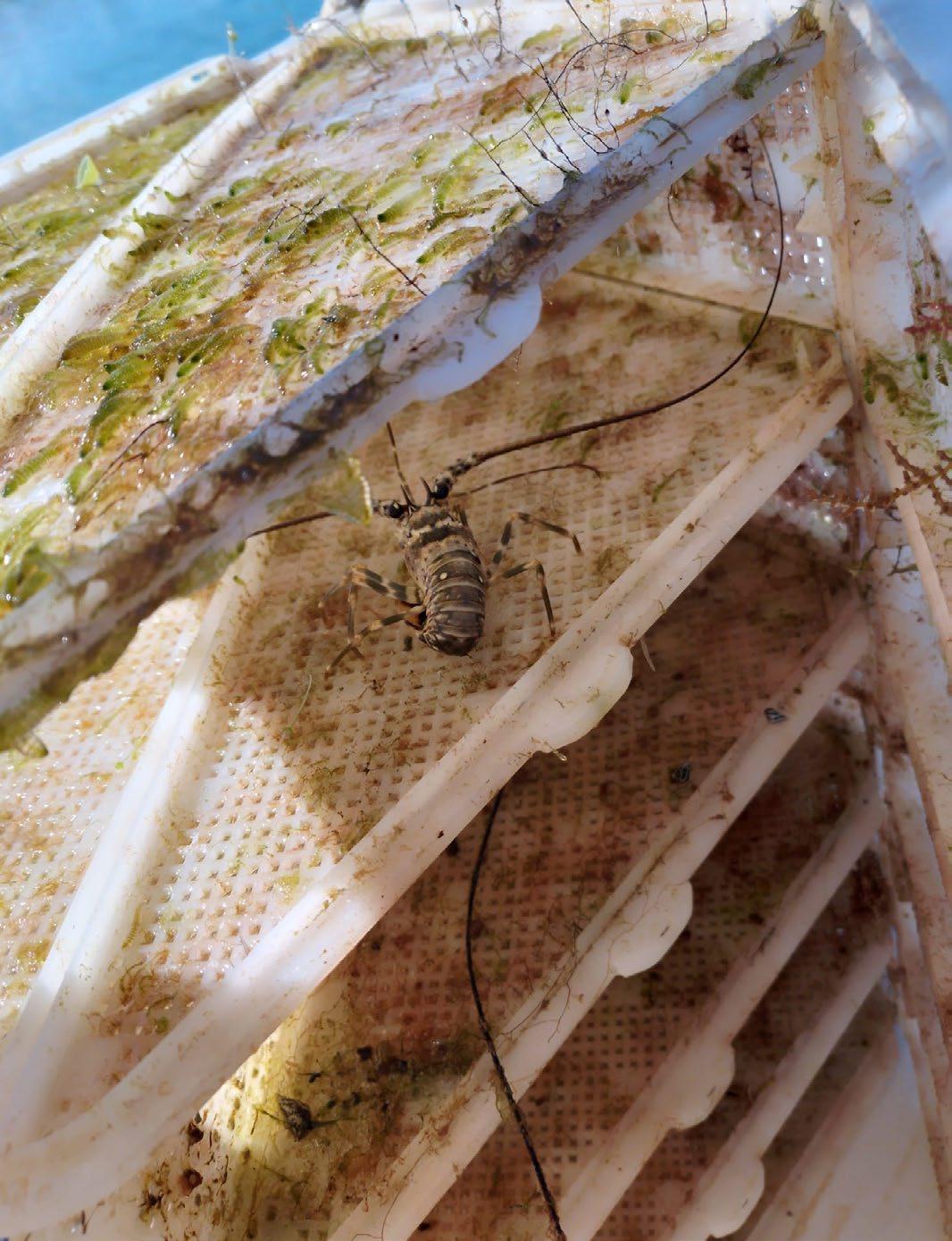




Coral reefs are one of the most biodiverse yet threatened ecosystems on the planet. Major threats include climate change, overfishing, pollution, and invasive species. This past summer 2024, the Smith Lab from Concordia University in Montreal, Quebec, Canada spent 3.5 months at CEI conducting lab and field-based research that addressed two main questions: 1) What are the effects of ocean warming on predator-prey dynamics in invasive lionfish and native parrotfish? and 2) What are the independent
and cumulative effects of human-caused drivers of change on coral reefs? MSc students Iris George and Katelyn Moffat along with research assistant, Tafari Smith, a recent graduate from the University of The Bahamas’ Small Island Sustainability BSc program, also spent several weeks at CEI advancing their scuba diving skills. This past summer, they obtained both PADI Advanced Diver and PADI Rescue Diver certifications from CEI staff.
Iris and Katelyn are the first graduate students of Dr. Nicola S. Smith’s lab, which was formed in May 2023. The Smith lab, also called the Drivers of Environmental Change in the Ocean (DECO) lab, uses coral reefs in The Bahamas as a model system to study: 1) climate change effects on marine systems, 2) marine invasions, and 3) their intersection. The DECO lab also monitors long-term changes on coral reefs to quantify both natural and human-caused drivers of change in these systems.
As the principal investigator of the DECO lab, Dr. Smith has a unique relationship with CEI. Dr. Smith has been conducting research at CEI since 2011, first as a consultant for the Bahamian government on a UNEP/GEF funded project on invasive lionfish control, and then as a PhD student of marine ecology at Simon Fraser University in British Columbia, Canada. Dr. Smith is a Bahamian and one of the founding members of the recently formed Bahamas Academy of Sciences. In 2024, Dr. Smith became an adjunct researcher at CEI and hopes to maintain a long-term relationship with the institute. In addition to graduate student research at CEI, Dr. Smith created the first Coral Reef Ecology and Conservation undergraduate student field course at Concordia University, which will be hosted at CEI this summer 2025.


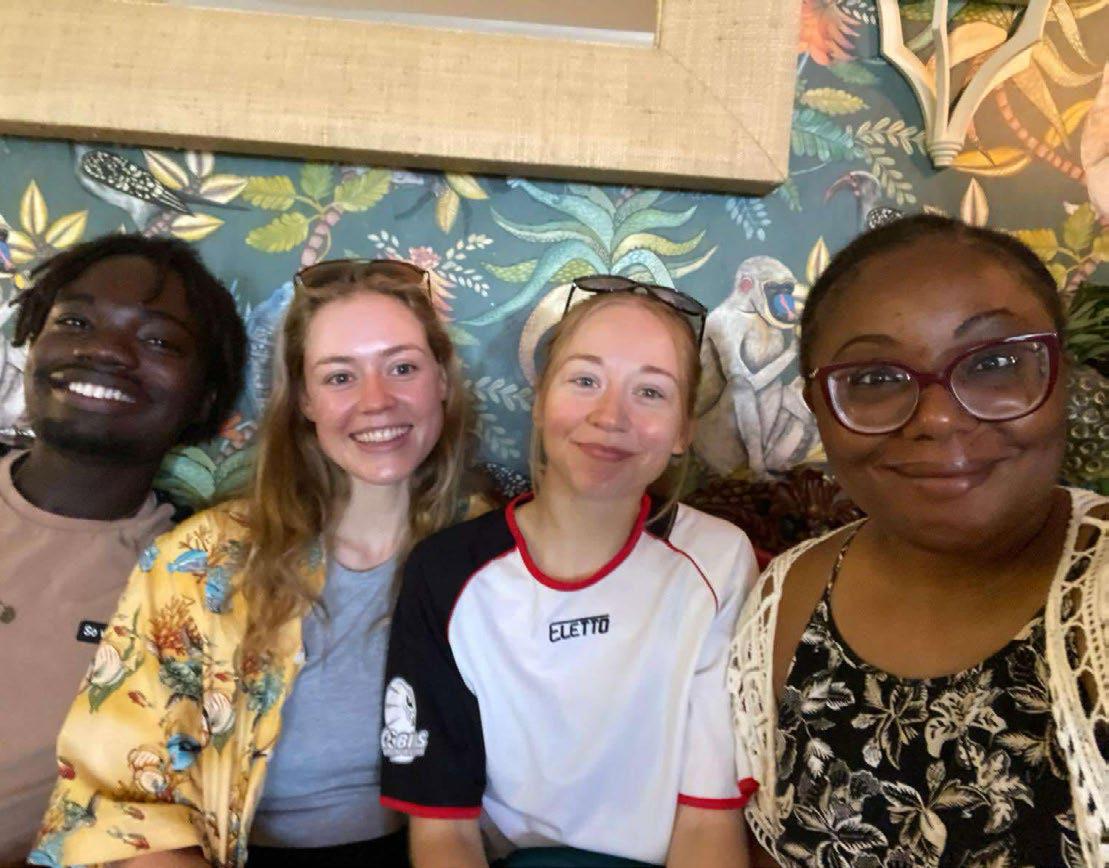

Did you know that a staggering 64 percent of the world’s ocean and seabed lie beyond the territory of individual countries? This huge noman’s land, technically known as ‘The Area,’ contains vast mineral resources and there is a growing push to begin mining the deep seabed. What impact will this have on the ocean ecosystems and who stands to benefit?
In August, Dr. Nick Higgs, Director of CEI, joined a delegation from The Bahamas to the 29th Assembly of the International Seabed Assembly (ISA) in Jamaica, the intergovernmental body tasked with managing and regulating deep-sea mining. The landmark United Nations Convention of the Law of the Sea (UNCLOS) declares that the resources in The Area are “the common heritage of all mankind.” Therefore all countries, including The Bahamas, have an equal say in how these resources are used and an equal right to the benefits from these resources. As a Bahamian with a Ph.D. in deep-sea ecology, Dr. Higgs was invited as a technical advisor and has previously represented The Bahamas in helping the ISA develop environmental management plans for deep-sea mining in the midAtlantic ridge area.

The Bahamas took on an active role at the ISA Assembly meeting. The Minister of Environment and Natural Resources, Hon. Vaughn Miller, delivered a speech stressing the need to prioritize the protection of the marine environment. The Minister was clear on The Bahamas’ position calling for “robust environmental
regulations, stringent monitoring mechanisms and comprehensive impact assessments to minimize the adverse effects of deepsea mining.” He went on to say that, “As a big ocean state… We understand the critical importance of preserving and protecting our marine ecosystems for current and future generations.”
As a big ocean state… We understand the critical importance of preserving and protecting our marine ecosystems for current and future generations.”
HON. VAUGHN MILLER, MINISTER OF ENVIRONMENT AND NATURAL RESOURCES
The Bahamas has been a leading voice in pushing the international community to act on climate change. Humanity needs to work collectively towards net-zero carbon emissions if we are to halt the worst effects of climate change. One view is that we are going to need mineral resources like the cobalt, nickel and manganese from deep sea deposits to build the batteries needed for a global shift towards green energy. In other words, maybe deep-sea mining is a necessary risk we have to take. Yet others argue that new battery technologies and recycling make the need for deep-sea mining obsolete, and that we should not risk the potential damage to large parts of the marine environment.
Many observers thought of the 29th Assembly as a critical juncture where key issues were addressed. For example, several countries have put forward a proposal for a “general policy … for the protection and preservation of the marine environment,” that would facilitate a transparent and well-informed discussion about how the ISA implements its legal duty to protect the environment (Article 145 of UNCLOS). The ISA has made significant strides in this area and takes its
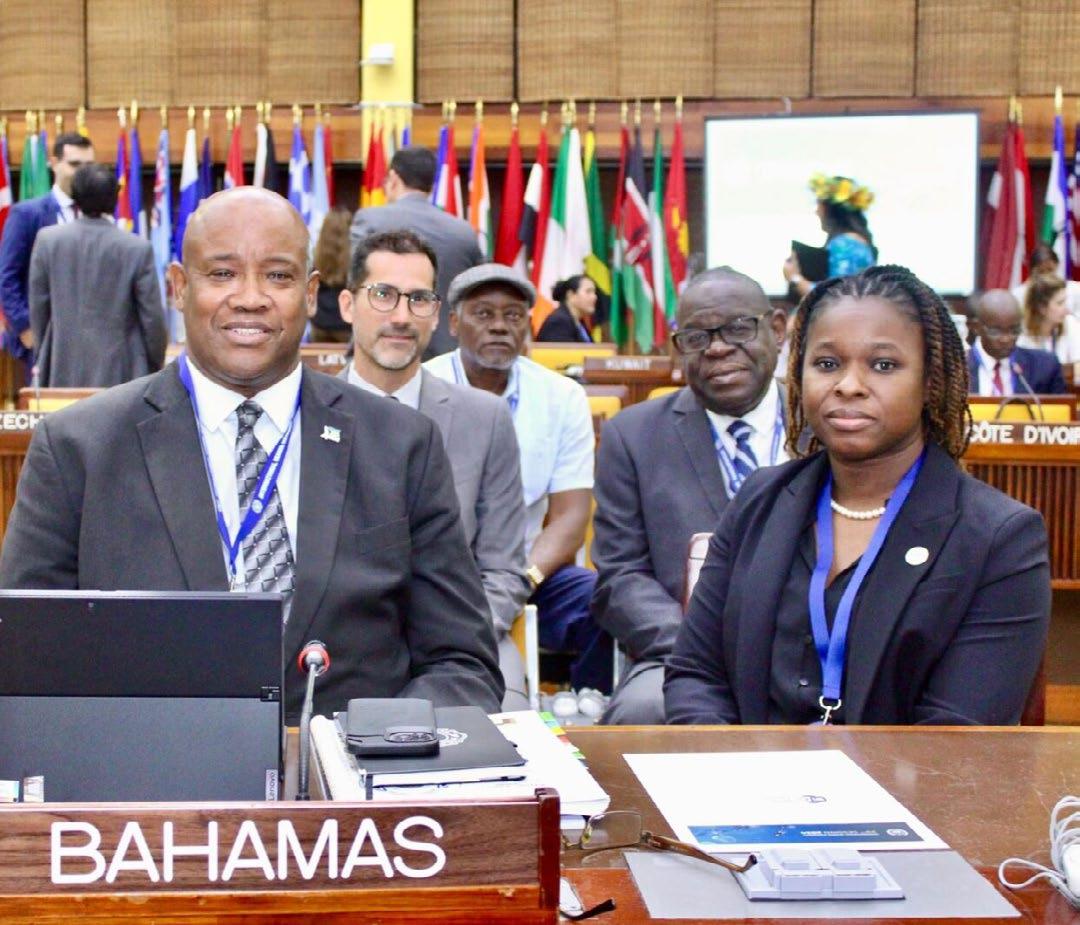
responsibility seriously, but many scientists feel that we just don’t have enough scientific information to understand the impacts that mining might have on the environment.
There are a growing number of countries calling for a “precautionary pause” on advancing deep-sea mining until robust regulations are in place. The draft regulations that would govern mining activities are not yet finalized, but an obscure technical rule has raised the prospect that some contractors can apply to start mining even if the regulations are not complete. Many member countries see this as unacceptable and are keen to see the regulations completed.
CEI has led the way in exploring deep-sea habitats in The Bahamas, recently describing a new species of deep-sea isopod. We continue to advocate for the conservation of and connection to all parts of our environment, as well as the safe and sustainable use of natural resources. It is a privilege to use our expertise to support the government of The Bahamas and play our part in the global community to ensure a sustainable future for our planet and its people.


In May 2024, Dr. Eric Schneider and CEI Adjunct Scientist Candice Brittain hosted stone crab fisher meetings on Long Island, The Bahamas, as part of a continued project to work with stone crabbers to test and promote a new claw harvest technique in the stone crab fishery. The meetings on Long Island marked the seventh island where the team have hosted these meetings, and a large percentage of the registered stone crabbers in the country have attended at least one of the workshops. The first meeting on Long Island was at the local Department of Marine Resources office with the head Fisheries Officer, during which the team presented data summaries from the past stone crab research projects and discussed the local state of the stone crab fishery.
A separate meeting was then held for fishers at the Long Island Harbour Club in Salt Pond settlement, a location recommended by a local fish house operator. The meeting was one of the most successful over the course of 2 years of this project, with 12 people in attendance and a very engaged audience. Sharing the data that has been collected on this fishery, which was all done in collaboration with stone crabbers from Eleuthera, has been an integral part of the success of this project, and this approach will continue into the future.
CEI Assistant Director Dr. Eric Schneider spent time in Saba, part of the Leeward Islands of the Caribbean, as a visiting presenter with Saba Sea and Learn. During the month of October, their program brings scientists to the island for various outreach activities on a range of topics. Dr. Schneider spent time giving presentations and running activities for Saban students and members of the community, sharing his research on fish aggregating devices (FADs) and learning from Saban fishers about their use of FADs in the area.

The Energy Research class at Deep Creek Middle School (DCMS) offered students a hands-on opportunity to explore sustainable energy solutions. By analyzing their current electricity consumption on campus, students gained a deeper understanding of their energy usage and costs. To reduce their reliance on diesel fuel, the class made improvements to their existing solar system, increasing its capacity to meet one-third of their electricity needs. Furthermore, the students designed a larger solar system with the potential to make the entire school energyindependent. To complement their theoretical knowledge, the class also engaged in practical solar cooking experiments, highlighting the versatility of solar energy.
Over the summer, CEI hosted the South Eleuthera Kids Camp for a morning at our aquaponics facility, where they learned about the critical topics of food security and sustainable farming systems, such as aquaponics. By engaging with our system, campers got to experience all aspects of the system first hand, including planting lettuce seeds, harvesting mature lettuce, and catching tilapia from tanks. Their enthusiasm was evident and several participants
even expressed interest in starting their own farms at home. Additionally, CEI organized an impromptu tour of the wetlab for the Green Castle Primary School. Students got a glimpse into some of the exciting research that is done at CEI, including lobster research and aquaponics. Many students, ranging from kindergarten to Grade 6, had never seen juvenile spiny lobsters before and were particularly excited to see and touch them in our tanks.
In the summer of 2024, CEI collaborated with the South Eleuthera Kids Camp, a program hosted by The Island School’s Community Engagement Department, welcoming children aged 9–12 to explore critical topics related to sustainability. Over several days in July 2024, campers participated in a series of immersive activities, including handson aquaponics work where they planted lettuce seeds, harvested mature plants, and caught tilapia from tanks. These experiences introduced them to the interconnected systems of food security and sustainable farming, leaving many campers eager to implement what they learned by starting small home farms.
During the camp, students were also introduced to renewable energy systems, where they explored solar-powered cisterns and engaged in solar cooking activities. These practical experiences demonstrated how clean energy solutions can enhance daily life and instilled a sense of excitement about the possibilities of sustainable innovation.
Additionally, the camp featured a visit to The Island School’s farm, where campers met with CEI’s farm team to learn about local flora, composting, and sustainable growing practices. They explored

plants commonly used for Bahamian bush tea and traditional medicine, gaining an appreciation for the natural resources of their island and the cultural significance of these practices.
To round out their learning, led by the Bahamas Coral Innovation Hub, campers ventured into the marine world with a snorkeling excursion at a nearby coral reef. This awe-inspiring activity brought lessons about coral ecosystems to life, encouraging them to see themselves as stewards of the environment.
The Bahamas Coral Innovation Hub team (BCIH) at CEI provided Open Water Scuba training to Bahamian residents in South Eleuthera enrolled in the Young Leadership Program at The Island School. These young leaders become positive role models in their communities while building character and also their diving skills. After completing the Open Water course, our team provided training about how to use and maintain coral nurseries coupled with coral outplanting techniques to aid coral restoration efforts, and received a PADI Specialty certification created by the Perry Institute for Marine Science (PIMS) called Reef Rescue Diver. The students then assist with maintenance of The BCIH nursery located off the southwest shore of South Eleuthera. Additionally, the students learn how to build coral nursery trees, coral fragmentation techniques and how to populate a coral nursery tree with fragmented coral. The BCIH team created several educational resources for a wide range of ages, including interactive lessons about coral and fish identification, bleaching and coral restoration techniques. Students not only learn common Caribbean coral species, but also learn about the benefits and threats to coral reefs.
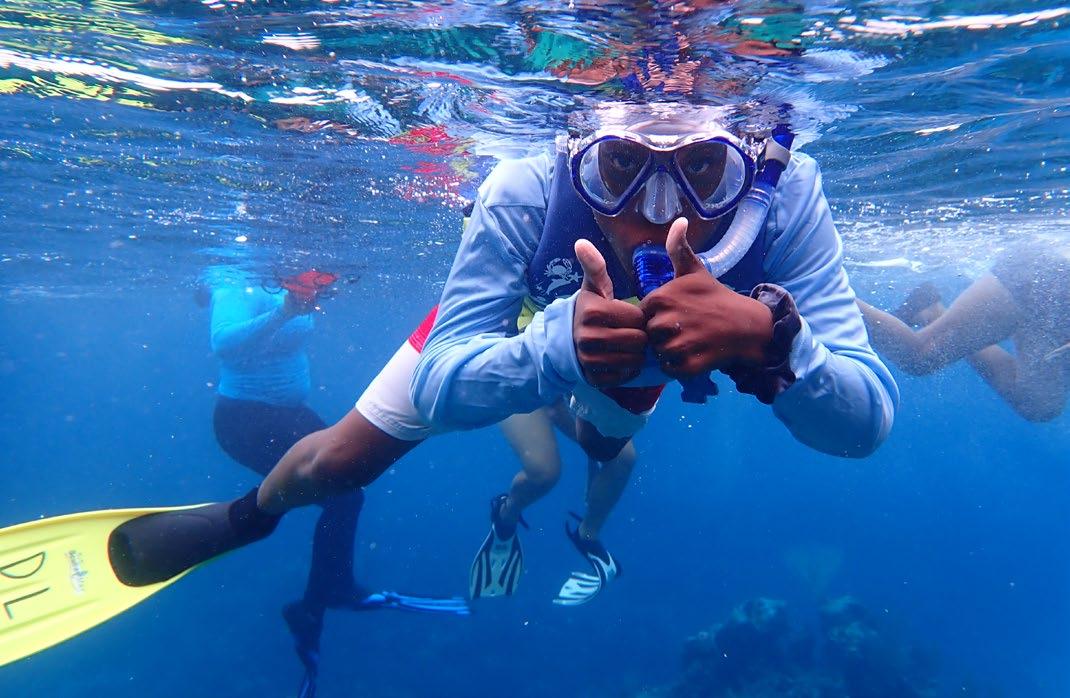
None of the work presented here would happen without the hard work of our scientists, engineers, research assistants, technicians and interns. Working in project teams to deliver our mission, often going above and beyond, they are the engines of innovation at The Island School. Thank you to everyone who worked with us in 2024.
RESEARCH &
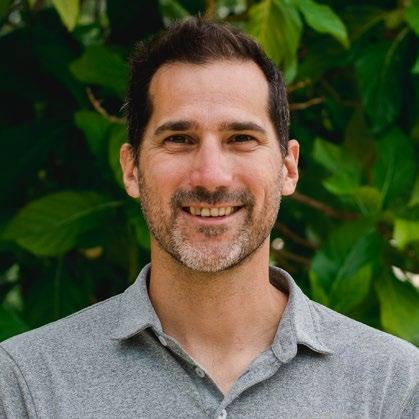
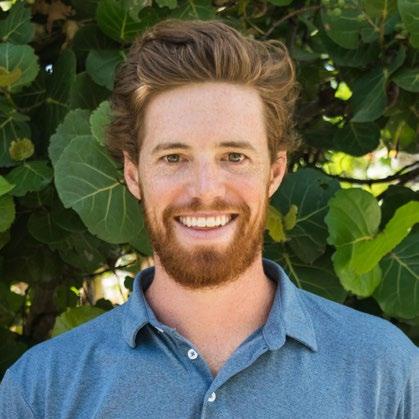



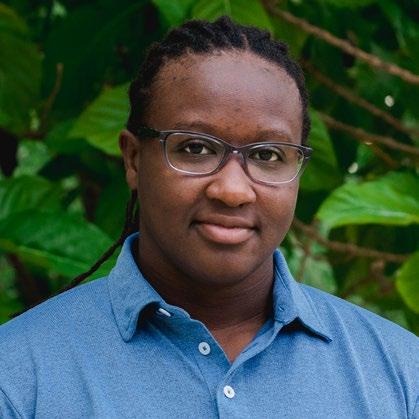
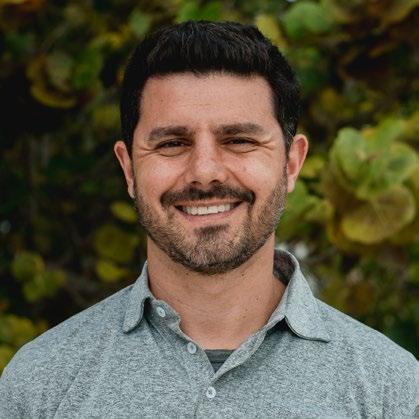



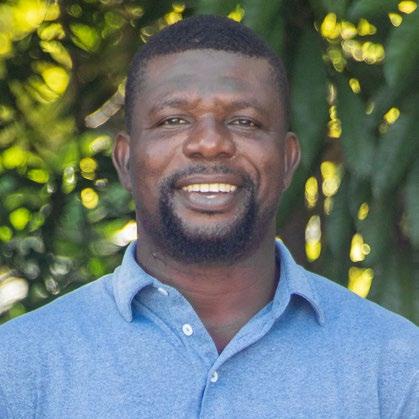


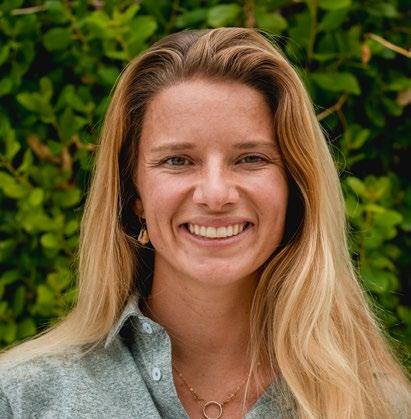
Dr. Nicola Smith, Concordia University
Dr. Kurt Gamperl, Memorial University of Newfoundland
Emma Porter, Memorial University of Newfoundland
Dr. Michael Bowleg, University of Exeter
Dr. Rob Ellis, University of Exeter
Marco Turner, Acadia University
Delphine Carroll, Wageningen University
Robbert Geertsma, Wageningen University
RESEARCH ASSISTANTS & TECHNICIANS
Amelia McDonald, Research Technician
Amy Brooks, Research Assistant
Andrew Treat, Research Assistant
Aqilah Ali, Research Assistant
Euguene Thompson, Research Technician
George Smith, Research Technician
Isabelle Genier, Research Technician
Isaiah Shewell, Research Technician
Laurens Schroeder, Research Technician
Leighton Graham, Research Assistant
Nick Wilson, Research Technician
Sarontaa Bain, Research Technician
Taylor Cargill, Research Assistant
Vincent Pastor, Research Assistant
April Wilder
Audrey Bowen
Bai Klap
Carlyn Cunningham
Charlotte Glavota
Che Nicholls
Ellie Thorson
Grace Alberts
Grant Fox
Kristin Wallace
Lilli Ward
Madalyn Saddler
Madelyn Richardson
Merrill Willis
Nick Wilson
Sam Wemmer
Sonne Seymour
Sui Yu
Tamara Dörfer
Will Philbin-Cross
Zara Wilson

• Eric attended to present on the stone crab fishery project
• Eric hosted a symposium session entitled ‘Centering fisher questions and collaborations in research and conservation’
• Eric and Natascha attended to present on the shark behavior and human interactions projects
• Science day 2024Animals in a changing world, Wageningen, The Netherlands
• Natalia (poster): Towards resilience reef restoration, using larval propagation of Stony Corals
• Mia Avril and Silia Woodside attended through sponsorship from Biomar and Aquasafra Inc.
• Natalia submitted abstract: Using coral mariculture as a tool towards resilient reef restoration in South Eleuthera, The Bahamas
• Natalia (oral presentation): A multitechnique approach of ecological restoration in South Eleuthera with The Bahamas Coral Innovation project
• Silia (poster): Outreach and Community Engagement as a key tool for coral restoration in South Eleuthera
• Kennedy (attended)
In September, CEI’s Aquaculture Manager, Mia Avril, and Junior Coral Researcher, Silia Woodside had the opportunity to attend the LACQUA 24 conference in Medellin through sponsorship from Biomar and Aquasafra Inc. The conference was organized by the World Aquaculture Society (WAS) for the Latin America and Caribbean chapter. This gathering brought together a diverse group of participants primarily from Central and South America, the United States, and a few Caribbean territories.
The conference featured a wide range of topics, covering innovative systems, as well as health, nutrition, physiology and general biology of various species in aquaculture. It was fascinating to see the breadth of research being conducted, showcasing groundbreaking advancements that have the potential to transform our industry.
A highlight of the conference was the tradeshow, where numerous industry players showcased their equipment and inputs for aquaculture, including innovative feed solutions. This was an excellent opportunity for attendees to explore new products and connect with suppliers who can support
their aquaculture operations- such as improvements to our wetlab here at Cape Eleuthera.
Networking was another key aspect of this conference. It was particularly significant as it marked the first time that contributions from the English-speaking Caribbean were included in this chapter meeting. Twelve members of the Caribbean Aquaculture Education and Innovation Hub (CAEIH), including the two representatives from the CEI were present, making it a momentous occasion for our community. Engaging with fellow aquaculture researchers, farmers, and government representatives was invaluable, and we look forward to exploring potential collaborations in the future.
Overall, LACQUA 24 was a remarkable experience that not only highlighted the advancements in aquaculture but also fostered connections across the region.We are excited to incorporate what was learnt into ongoing research and to continue contributing to the growth of aquaculture in the Caribbean.
Avril, M., Poulton, M. (2024). The formulation of aqua feed using locally sourced ingredients for Nile tilapia in The Bahamas. Jr Aqua Mar Bio Eco: JAMBE-135.
Wosnick, N., Curtis, D., Hauser-Davis, R. A. (2024). Managing technology-critical elements from electronic waste in Small Developing Island States: a burden or an opportunity?. Frontiers in Marine Science, 11, 1459794.
McGaw I., Curtis D. L., Van Leeuwen T. E., Schneider E. V. C. The feasibility of a claw-only fishery for the red rock crab, Cancer productus. Fisheries Management and Ecology.
Allerton A. J. L., Schneider E. V. C., Kiszka J. J., Talwar B. S (2024). Trends in marine mammal bycatch in U.S. fisheries from 1990 to 2017. Aquatic Conservation: Marine and Freshwater Ecosystems.
Lee, C-S., Shipley O., Ye, X., Fisher, N., Gallagher, A., Frisk, M., Talwar, B., Schneider, E. V. C., Venkatesan, A (2024). Accumulation of per- and polyfluoroalkyl substances (PFAS) in coastal sharks from contrasting marine environments: The New York Bight and The Bahamas.
Hiung, DLCYLS, Schuster, J. M., Duncan, M. I., Payne, N. L., Helmuth, B., Chu, J. W. F., Brambilla, V., Bruno, J., Davies, S., Dornelas, M., Guy-Haim, T., Jackson, J., Madin, J. S., Monteith, Z. L., Queiros, A., Schneider, E. V. C., Starko, S., Talwar, B. S., Wyatt, A. S. J., Aichelman, H., Bensoissan, N., Baum, J. K., Caruso, C., Castillo, K., Choi, F., Dong, Y-W., Gagnon, P., Garrabou, J., Guillemain, D., Higgs, N., Jiang, Y., Kersting, D. K., Kushner, D. J., Leichter, J. J., Longo, G., Neufeld, C., Peirache, M., Smyth, T., Sprague, J. L., Urvoy, G., Zuberer, F., Bates, A. E (2024). Ocean weather, biological rates, and unexplained global ecological patterns. PNAS Nexus 3(8): 260.
Shipley, O. N., Bruce, N. L., Higgs, N. D., Rawlins, S., Irschick, D. J., Gutierrez, R., Moyer, J. K., Violich, M., Talwar, B. S., Schneider, E. V. C., Robinson, N. J., Brooks, E. J. (2024). A new species of deep-sea Booralana Bruce, 1986 (Crustacea: Isopoda: Cirolanidae) from The Bahamas, Western North Atlantic. Zootaxa.
Talwar, B. S., Brooks, E. J., Abercrombie, D. L., Anderson, B., Bond, M. E., Brooks, A. M. L., Chapman, D. D., Clementi, G. M., Fields, C. Y. A., Gelsleichter, J., Grubbs, D., Howey, L. A., Jordan, L. K. B., Kiszka, J. J., Knotek, R. J., Papastamatiou, Y. P., Peterson, C. T., Schneider, E. V. C., Shipley, O. N., Williams, S., Winchester, M. M., Heithaus, M. R. (2024). Insights into the Relative Abundance, Life History, and Ecology of Oceanic Sharks in the Eastern Bahamas. MDPI.
Wosnick, N., Schneider, E. V. C. (2024). Expanding records of occurrence of the whale shark (Rhincodon typus) in The Bahamas and a call for sustainable tourism practices. Journal of Fish Biology.
Wosnick, N., Langlais, M., Saunders, A. (2024). Behavioral dynamics and feeding strategies of sharksuckers in symbiosis with Atlantic Nurse sharks: insights from a fish cleaning station in The Bahamas. Mar Biol 171, 155.
Malorey, P., Porter, E. S., Gamperl, A. K., Briffa, M., Wilson, A. D. M. (2024). Swimming performance, but not metabolism, is related to a boldness-activity syndrome in schoolmaster snapper (Lutjanus apodus). Journal of Fish Biology. doi:10.1111/ jfb.15900
Sandrelli, R. M., Porter, E. S., and Gamperl, A. K. (2024). Hyperoxia does not improve the acute upper thermal tolerance of a tropical marine fish (Lutjanus apodus). Journal of Experimental Biology. doi:10.1242/jeb.247703
Nati, J. H. H., Malorey, P., Gamperl, A. K. (2024). Near maximally swimming schoolmaster snapper (Lutjanus apodus) have a greater metabolic capacity, and only a slightly lower thermal tolerance, than when tested at rest. J. Exp. Biol.
In 2024, thanks to your invaluable support, we have achieved significant milestones in advancing our research and conservation goals. We would like to extend our deepest gratitude to our generous funders and dedicated partners for their continued support. Together, we’ve made significant strides in protecting vital ecosystems, innovating sustainable solutions, and educating young minds that will lead the next generation of environmental stewards. We look forward to continuing this impactful journey together, fostering a healthier, more sustainable future for our oceans and the people who depend on them. Thank you for believing in our work!
Would you like to help us lead impactful conservation efforts in the Bahamas? We rely on strong, collaborative partnerships with visionary, practical, and passionate individuals to drive meaningful change.
We have the capacity to scale and manage significant funding, using it effectively to achieve measurable outcomes backed by scientific research. To explore how your philanthropic goals can support our research and innovation, please contact our Development Department by email at donations@islandschool.org


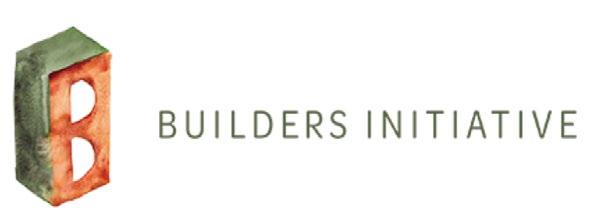




LILY FOUNDATION

ROBIN RIGBY TRUST



PROJECT PARTNERS


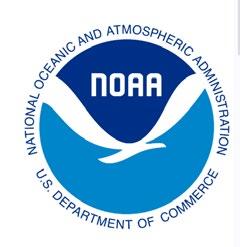





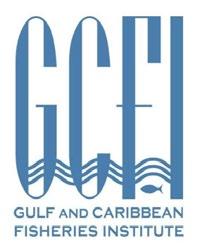

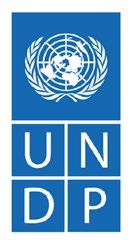
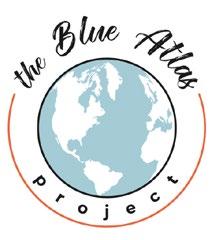
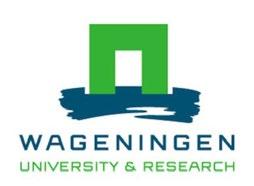
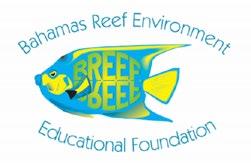




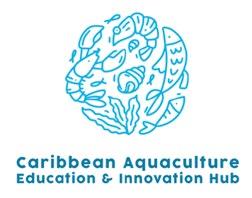
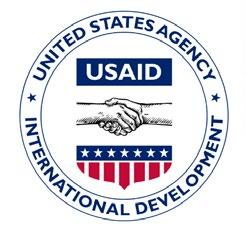

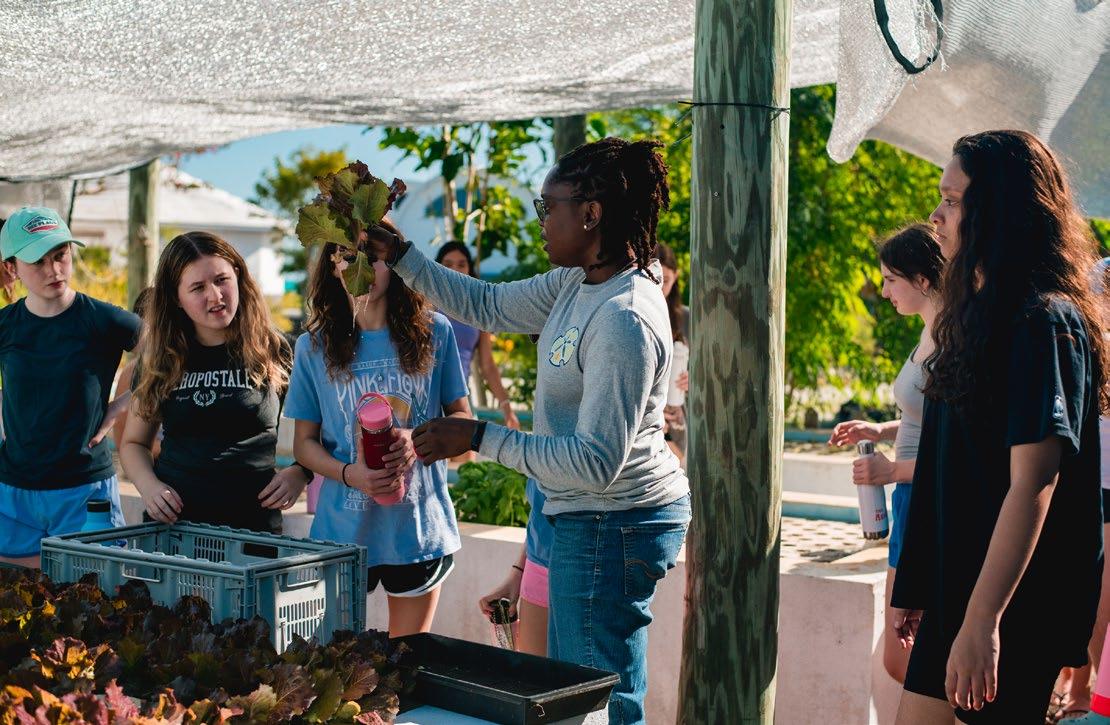
Are you looking for an exciting career opportunity? The Cape Eleuthera Institute is hiring! Visit islandschool.org/employment to explore our current openings.

